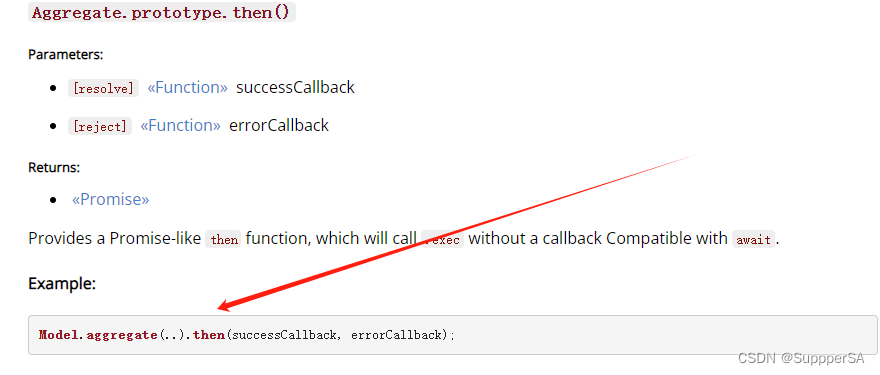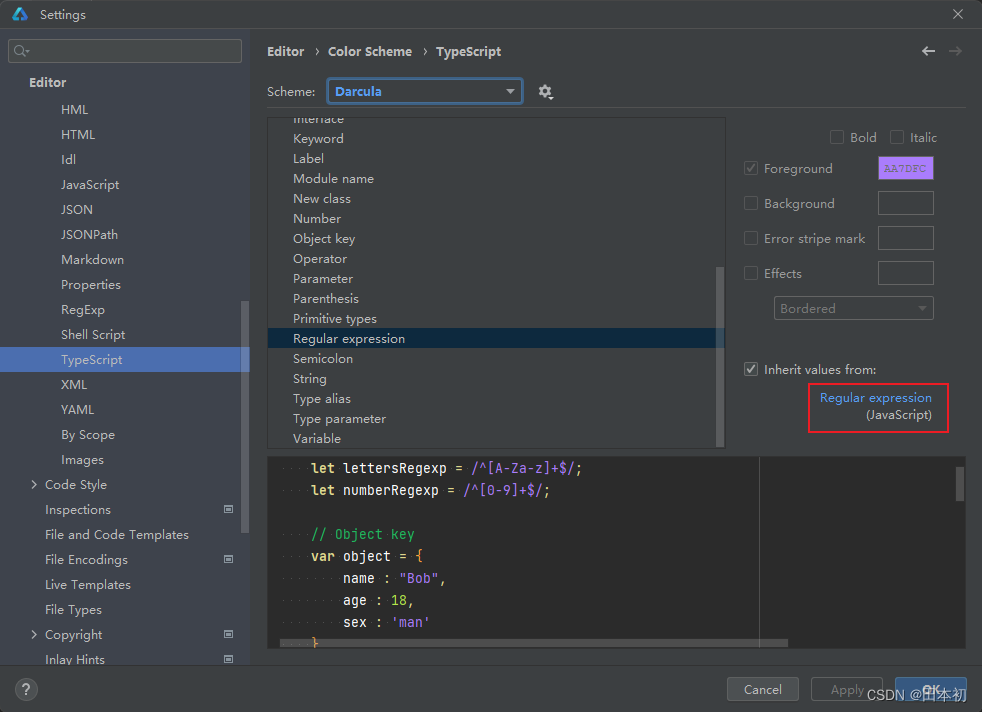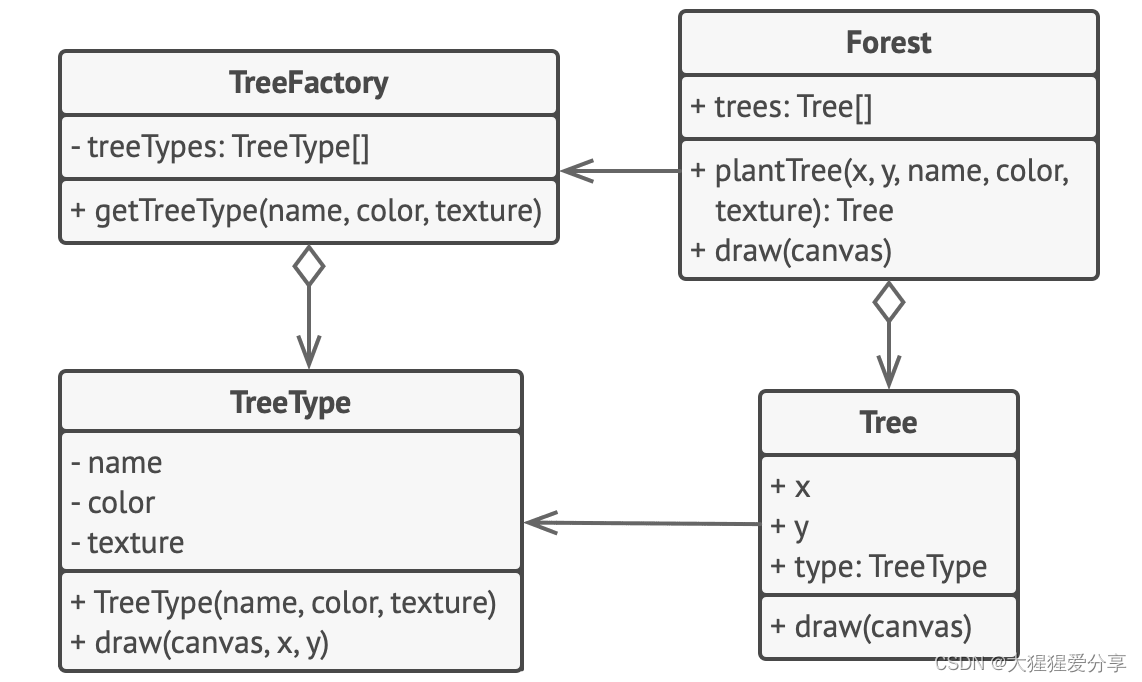IO流:存储和读取数据的解决方案
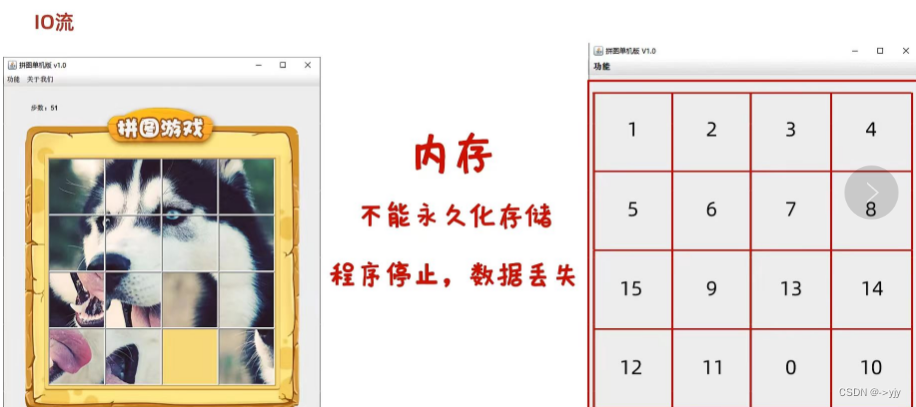

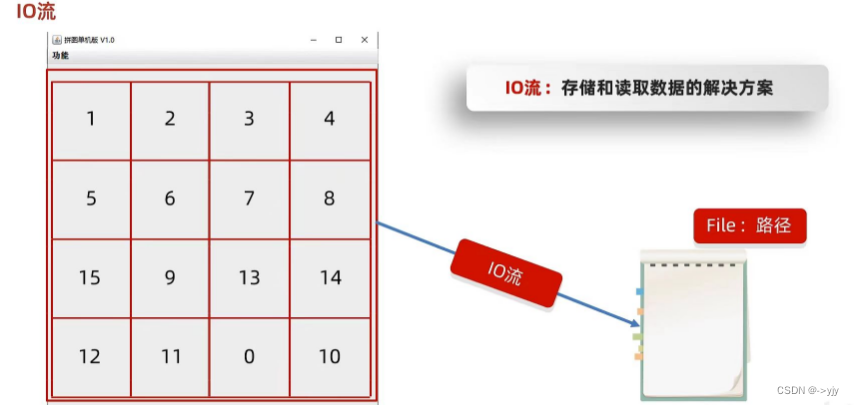
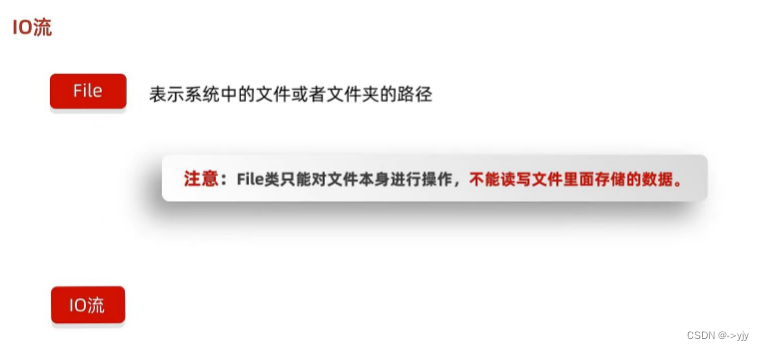

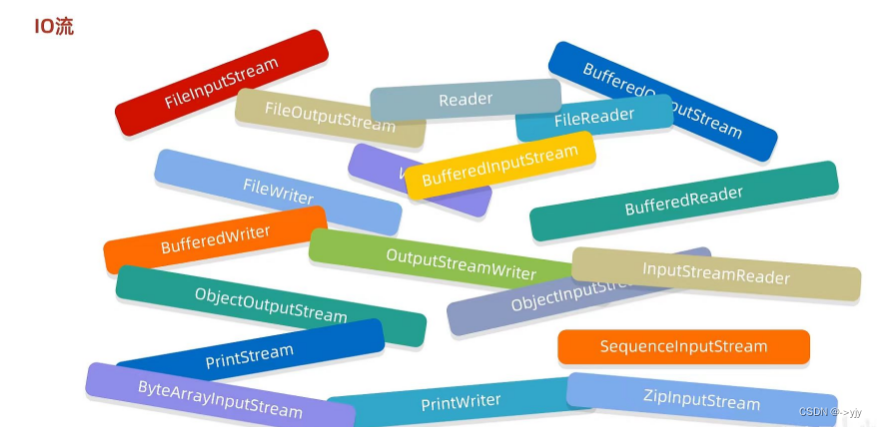
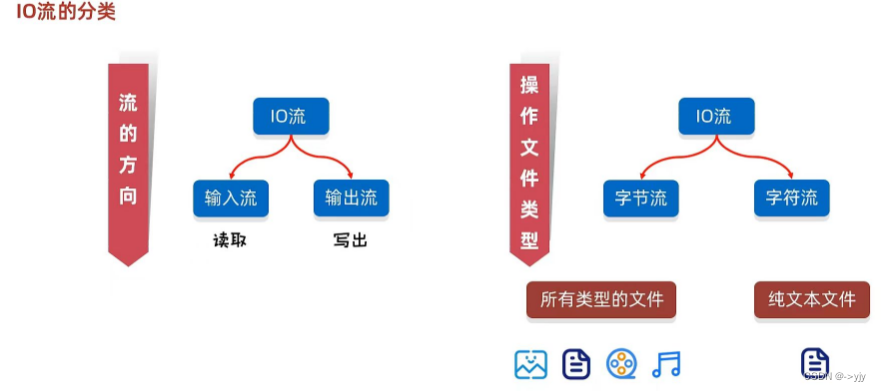
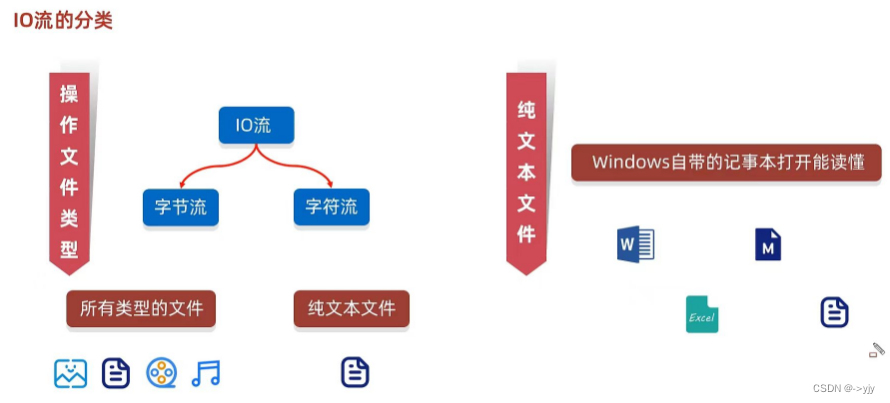


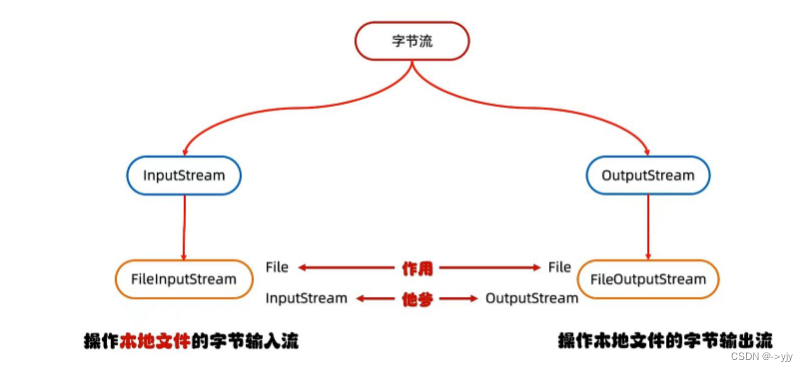
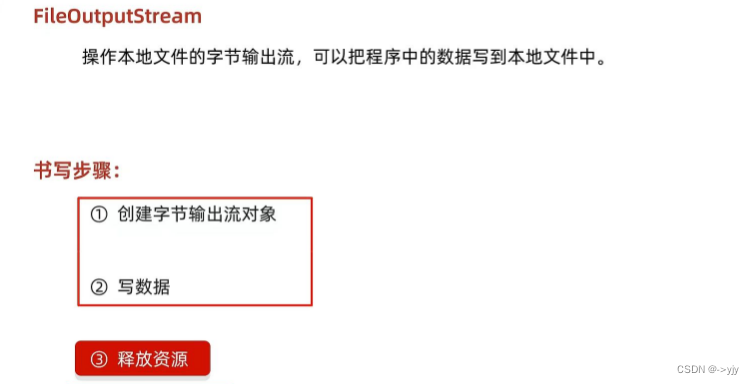
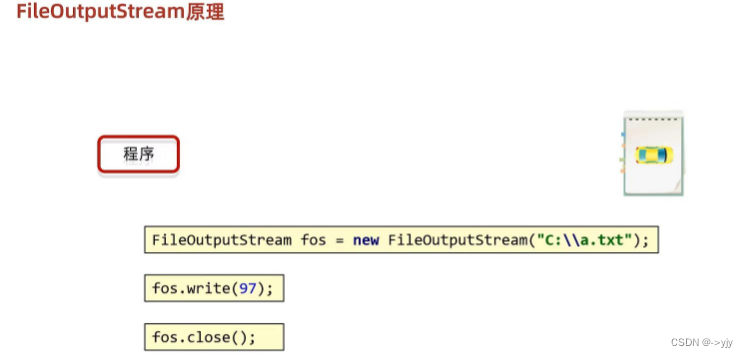
import java.io.FileOutputStream;
import java.io.IOException;
public class Test {
public static void main(String[] args) throws IOException {
//1.创建对象
//写出 输入流 OutputStream
//本地文件file
FileOutputStream fos =new FileOutputStream("basic-code\\1.txt");
//写出数据
fos.write(97);
//释放资源
fos.close();
}
}
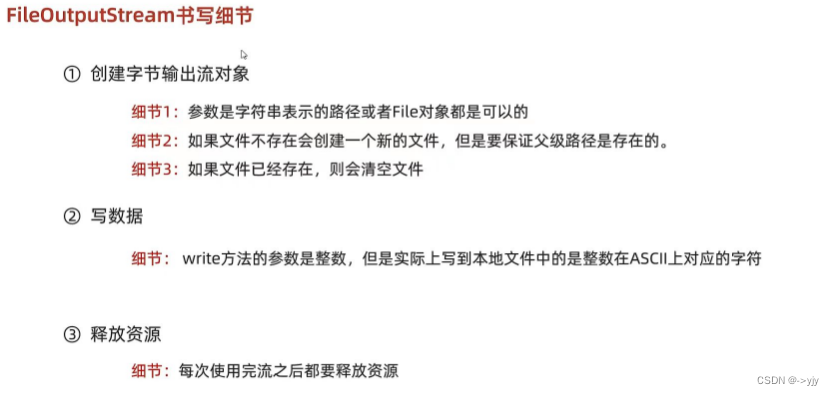

import java.io.FileOutputStream;
import java.io.IOException;
public class Test {
public static void main(String[] args) throws IOException {
FileOutputStream fos = new FileOutputStream("basic-code\\1.txt");
//fos.write(97);
//fos.write(98);
byte[] bytes={97,98,99,100,101};
//fos.write(bytes);
fos.write(bytes,1,3);
fos.close();
}
} 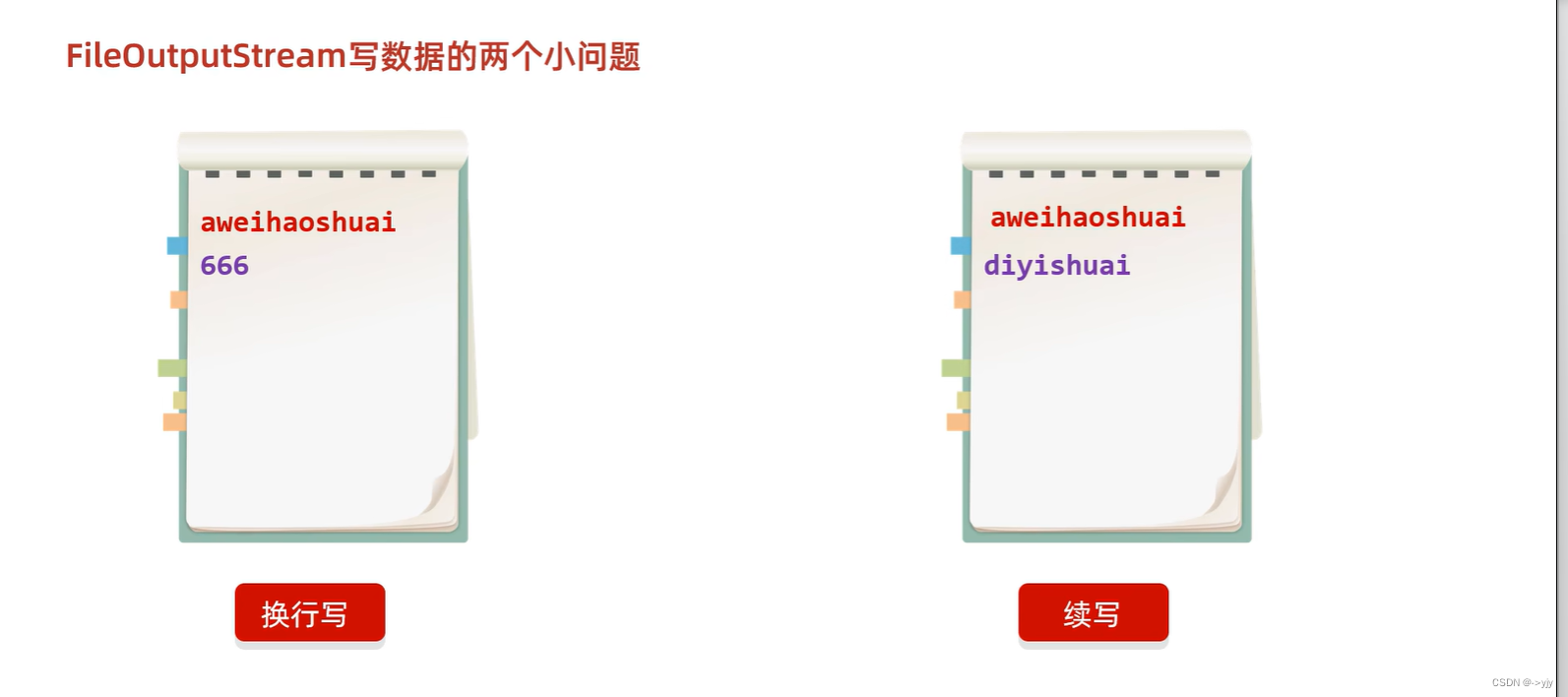
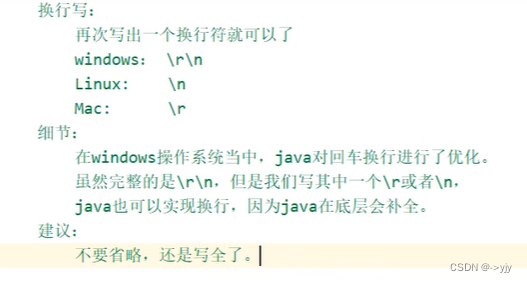
import java.io.FileOutputStream;
import java.io.IOException;
public class Test {
public static void main(String[] args) throws IOException {
FileOutputStream fos = new FileOutputStream("basic-code\\1.txt");
String str ="yjybainchangsigema";
byte[] bytes = str.getBytes();
// System.out.println(Arrays.toString(bytes));
fos.write(bytes);
String str2 = "\r\n";
byte[] bytes1 = str2.getBytes();
fos.write(bytes1);
String str3 = "come on";
byte[] bytes2 = str3.getBytes();
fos.write(bytes2);
fos.close();
}
}



import java.io.FileInputStream;
import java.io.IOException;
public class Test {
public static void main(String[] args) throws IOException {
FileInputStream fio =new FileInputStream("basic-code\\1.txt");
int read = fio.read();
System.out.println(read);
fio.close();
}
}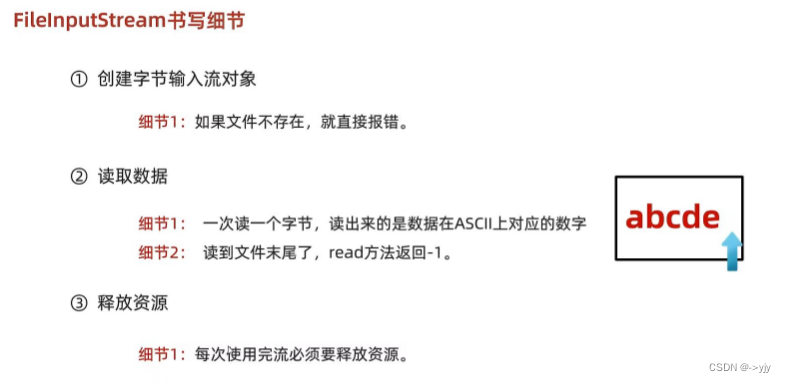

import java.io.FileInputStream;
import java.io.IOException;
public class Test {
public static void main(String[] args) throws IOException {
//字节输入流循环读取
FileInputStream fis =new FileInputStream("baisc-code\\1.txt");
int b;
/*
* read:表示读取数据,而且是读取一个数据就移动一次指针
* 如果没有变量b
* 假设文件数据abcde
* while((fis.read())!=-1){
System.out.println(fis.read);
* 相当于a!=-1 输出b
* c!=-1 输出d
* e!=-1 输出-1
* 因此第三方变量必须写
* */
while((b=fis.read())!=-1){
System.out.println((char)b);
}
fis.close();
}
}
文件拷贝的基本代码(小文件)
import java.io.FileInputStream;
import java.io.FileOutputStream;
import java.io.IOException;
public class Test {
public static void main(String[] args) throws IOException {
//文件拷贝
//1.创建对象
FileInputStream fis =new FileInputStream("D:\\iii\\movie.mp4");
FileOutputStream fos = new FileOutputStream("basic-code\\copy.mp4");
//2.拷贝
//核心思想:边读边想
int b;
while((b =fis.read())!=-1){
fos.write(b);
}
//3.释放资源
//规则:先开的最后关闭
fos.close();
fis.close();
}
}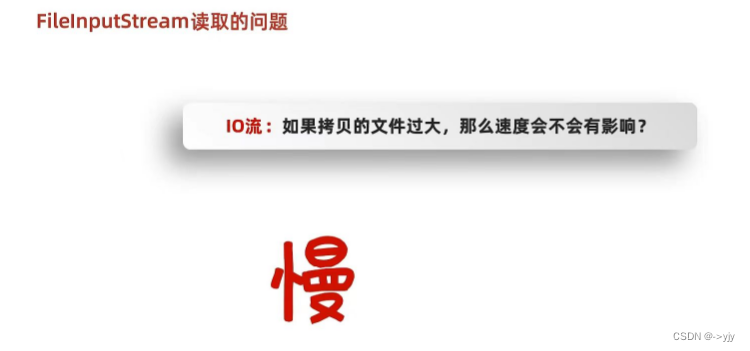
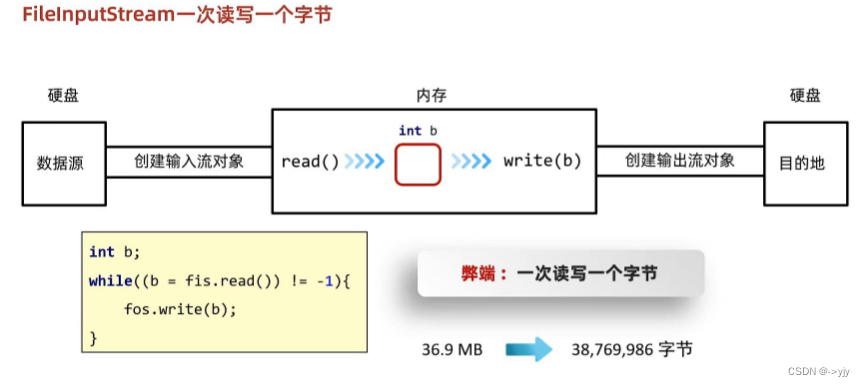



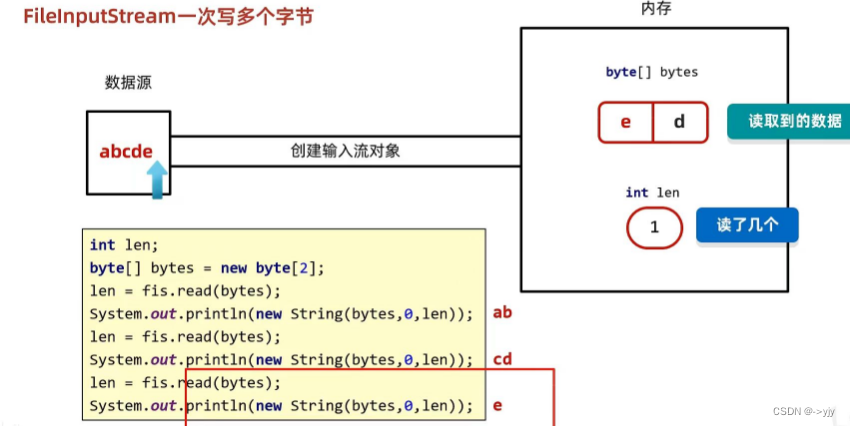
import java.io.FileInputStream;
import java.io.IOException;
public class Test {
public static void main(String[] args) throws IOException {
//1.创建对象
FileInputStream fis = new FileInputStream("basic-code\\1.txt");
//2.读取数据
byte[] bytes = new byte[2];
//一次读取多个字节数据 具体多少 跟数组的长度有关
//返回值 本子读取到多少个字节数据
int len1 = fis.read(bytes);
System.out.println(len1);//2
String str1 = new String(bytes);
System.out.println(str1);
int len2 = fis.read(bytes);
System.out.println(len2);//2
String str2 = new String(bytes);
System.out.println(str2);
int len3 = fis.read(bytes);
System.out.println(len3);//2
String str3 = new String(bytes);
System.out.println(str3);
fis.close();
}
}import java.io.FileInputStream;
import java.io.FileOutputStream;
import java.io.IOException;
public class Test {
public static void main(String[] args) throws IOException {
//文件拷贝改写
long start = System.currentTimeMillis();
FileInputStream fis = new FileInputStream("D:\\aaa");
FileOutputStream fos = new FileOutputStream("baisc-code\\a");
int len;
byte[] bytes =new byte[1025*1024*5];
while((len=fis.read())!=-1){
fos.write(bytes,0,len);
}
fos.close();
fis.close();
long end = System.currentTimeMillis();
System.out.println(end-start);
}
}
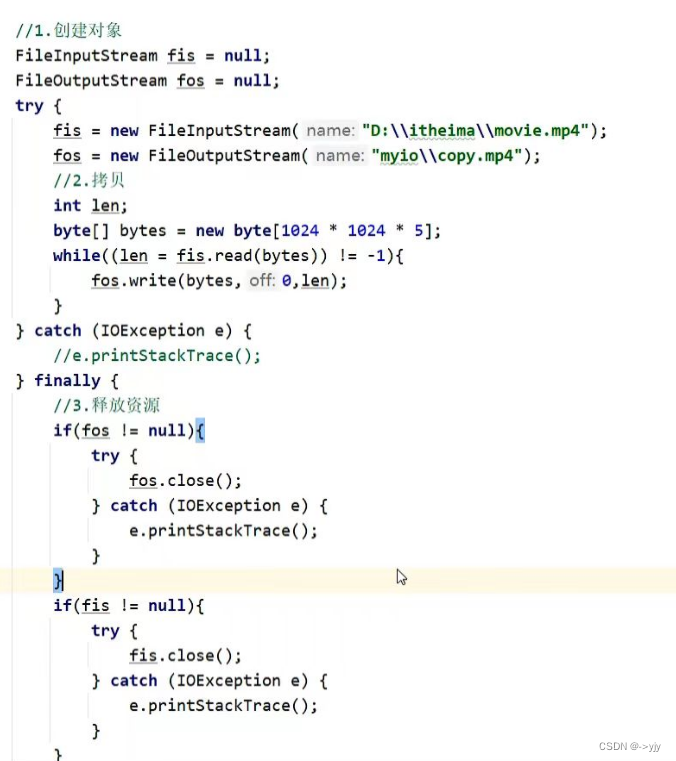
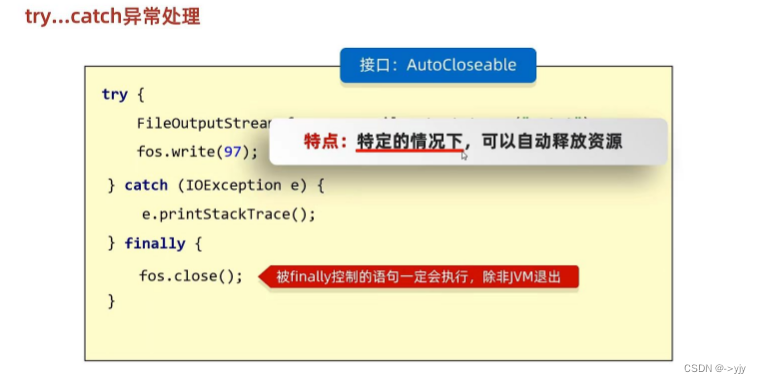
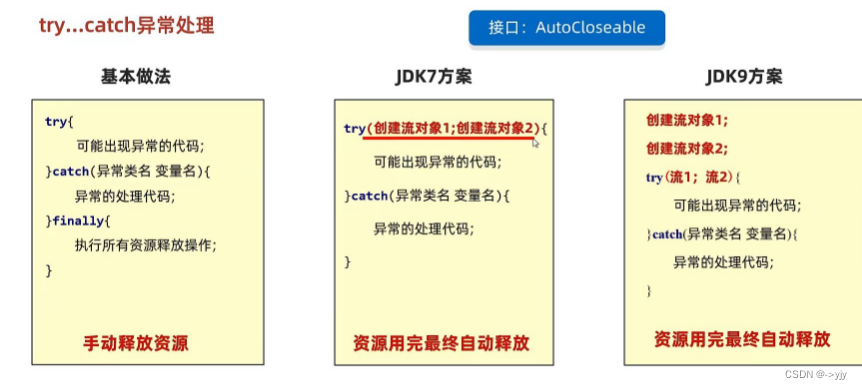
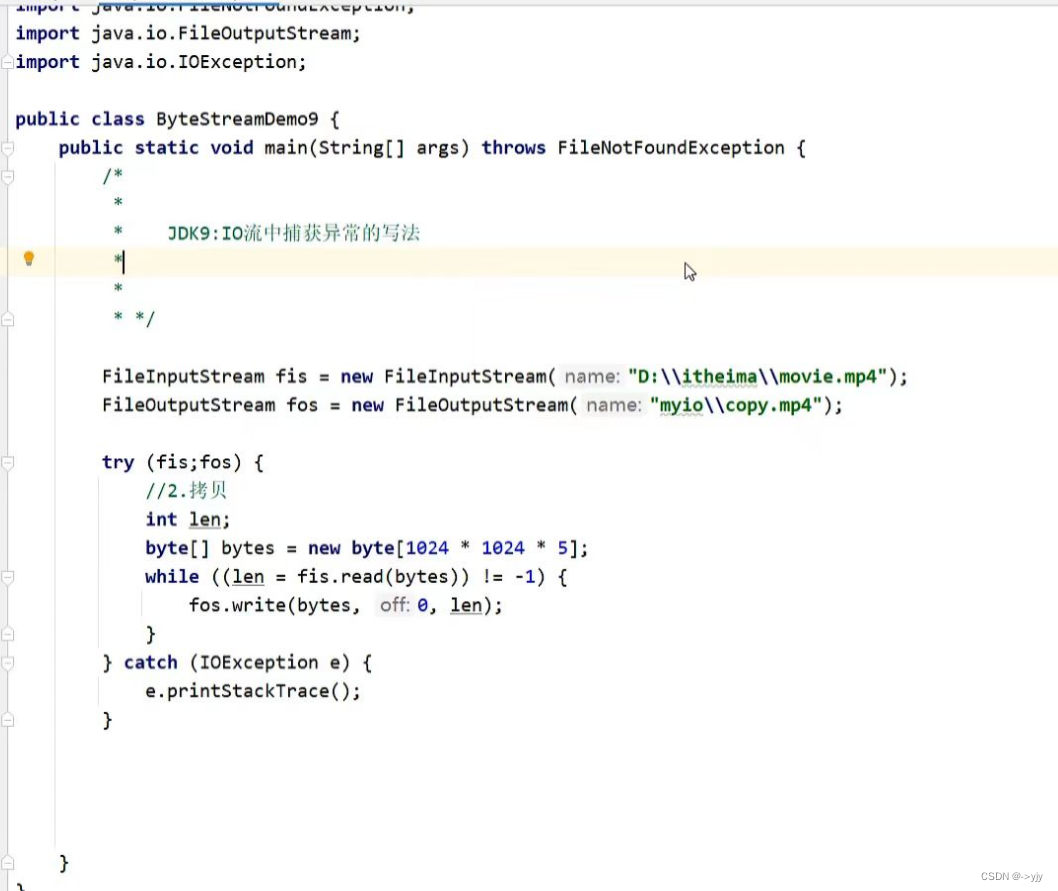
 字符集详解(ASCII, GBK)
字符集详解(ASCII, GBK)
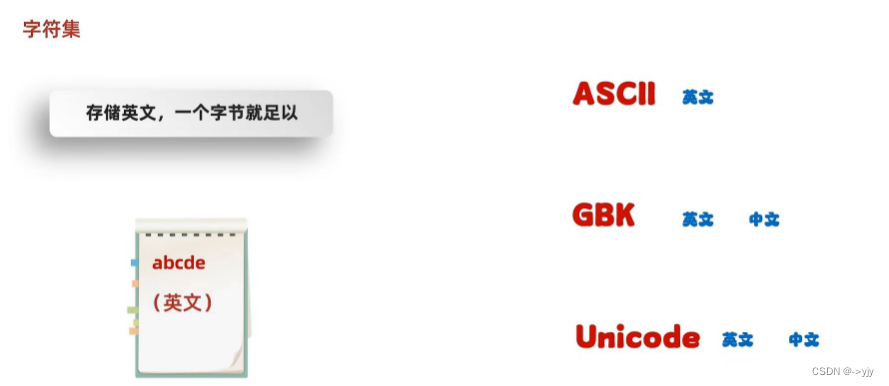

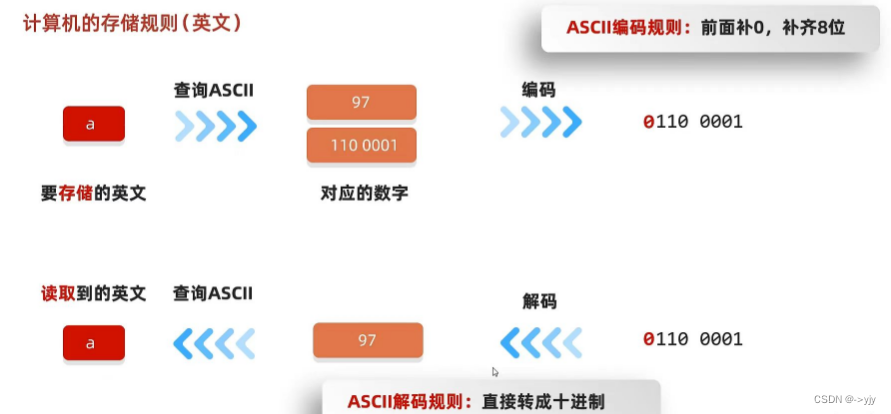
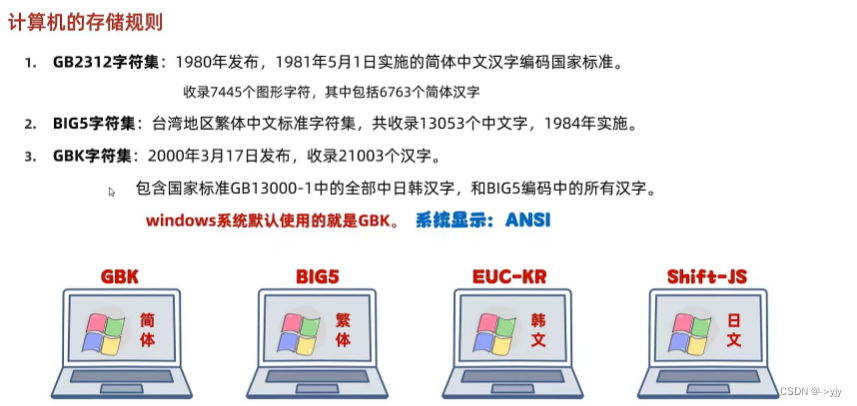

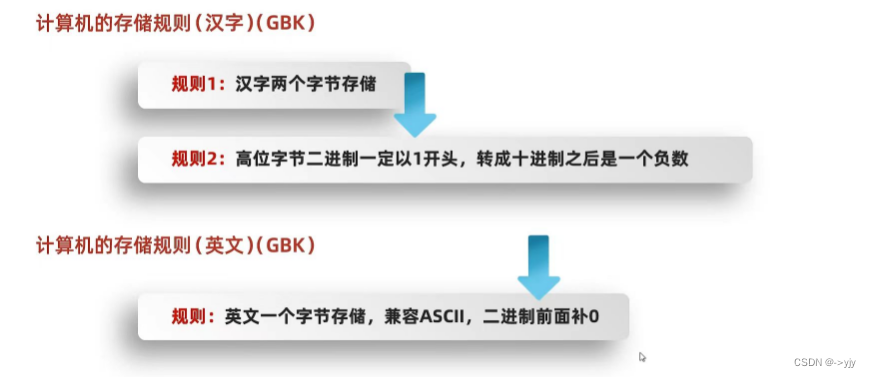
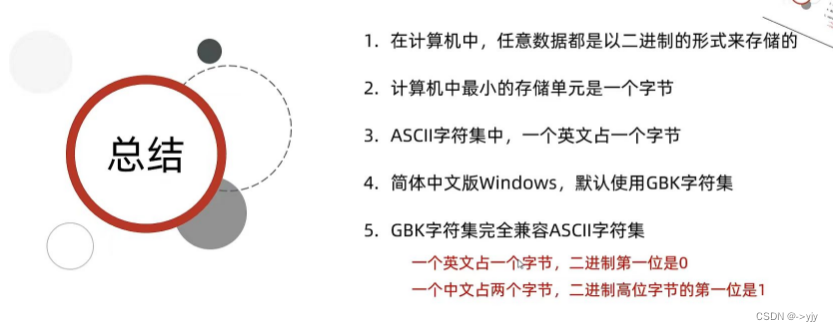
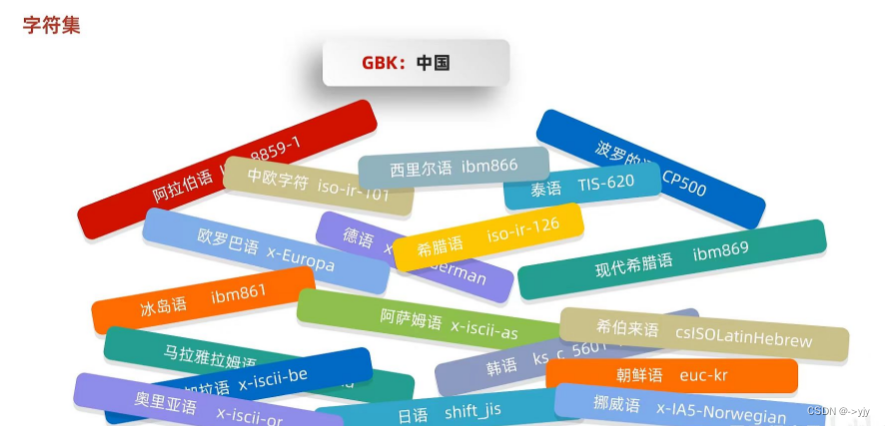

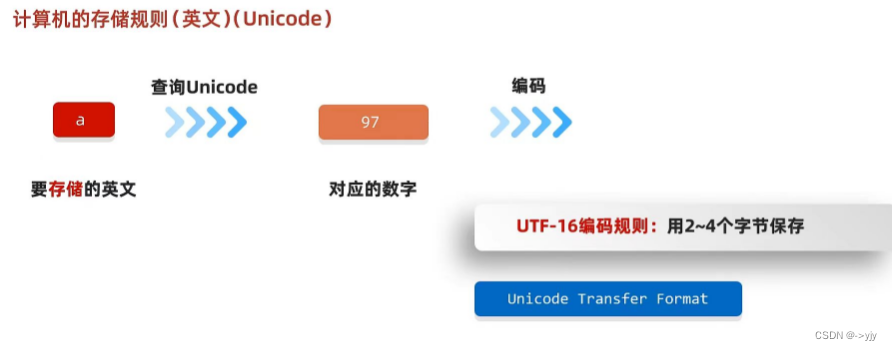
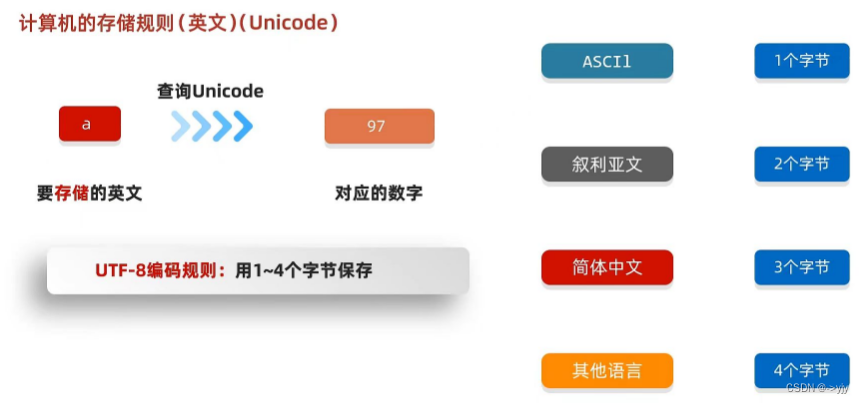

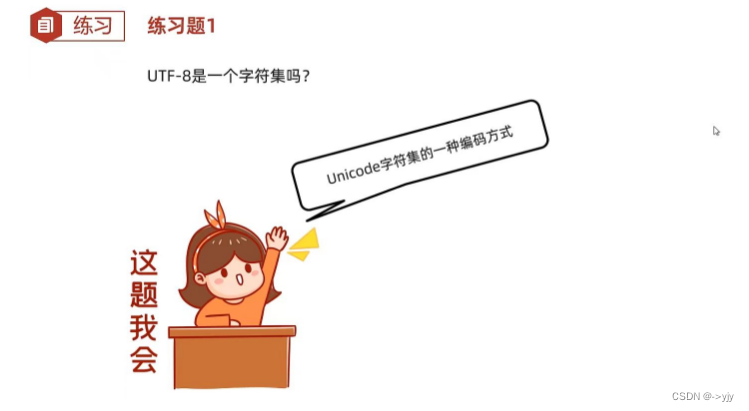


import java.io.FileInputStream;
import java.io.IOException;
public class Test {
public static void main(String[] args) throws IOException {
//字节流读取中文会出现乱码
FileInputStream fis = new FileInputStream("basic-code\\a");
int b;
while((b= fis.read())!=-1){
System.out.println((char)b);
}
fis.close();
}
}
数据流一个个拷贝 肯定就会出现乱码

import java.io.FileInputStream;
import java.io.FileOutputStream;
import java.io.IOException;
public class Test {
public static void main(String[] args) throws IOException {
//1.创建对象
FileInputStream fis = new FileInputStream("basic-code\\a.txt");
FileOutputStream fos =new FileOutputStream("basic-code\\1.txt");
//2.拷贝
int b;
while((b=fis.read())!=-1){
fos.write(b);
}
//3.释放资源
fos.close();
fis.close();
}
}记事本!数据不会丢失目的地和数据源保持一致
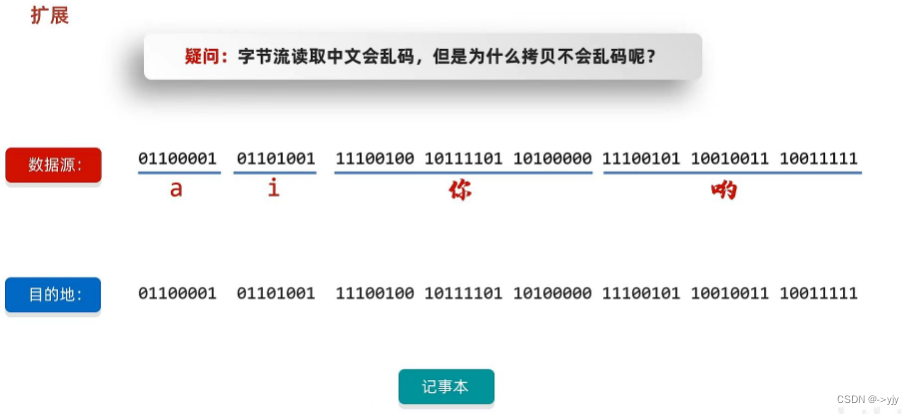


import java.io.IOException;
import java.util.Arrays;
public class Test {
public static void main(String[] args) throws IOException {
//1.编码
String str ="ai你哟";
byte[] bytes1 = str.getBytes();
System.out.println(Arrays.toString(bytes1));//???
byte[] bytes2 = str.getBytes("GBK");
System.out.println(Arrays.toString(bytes2));//???
//2.解码
String str2 = new String(bytes1);
System.out.println(str2);
String str3 = new String(bytes1,"GBK");
System.out.println(str3);
}
}
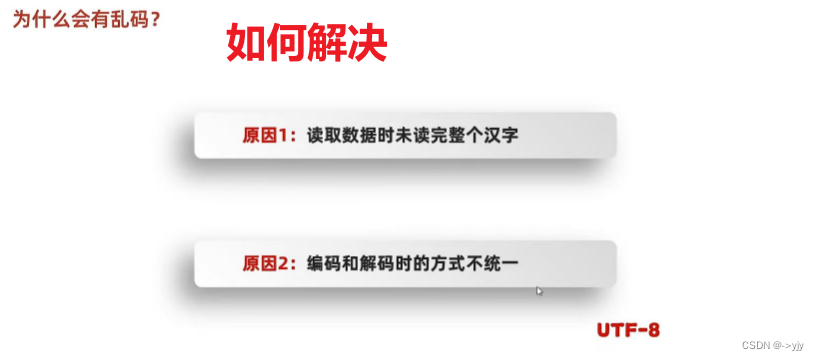
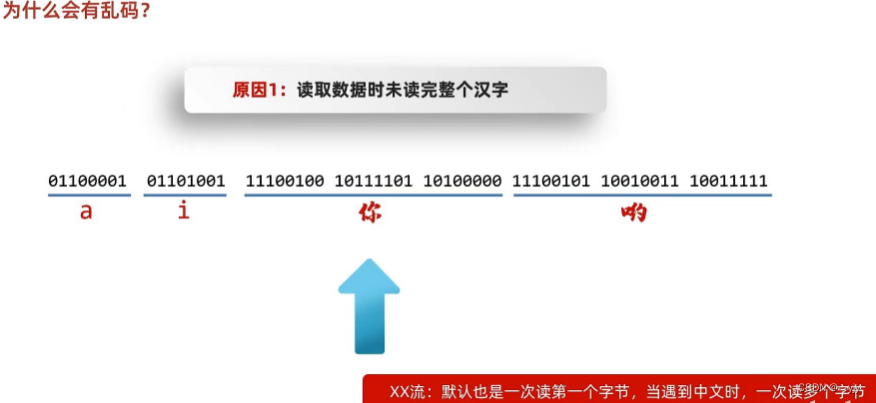
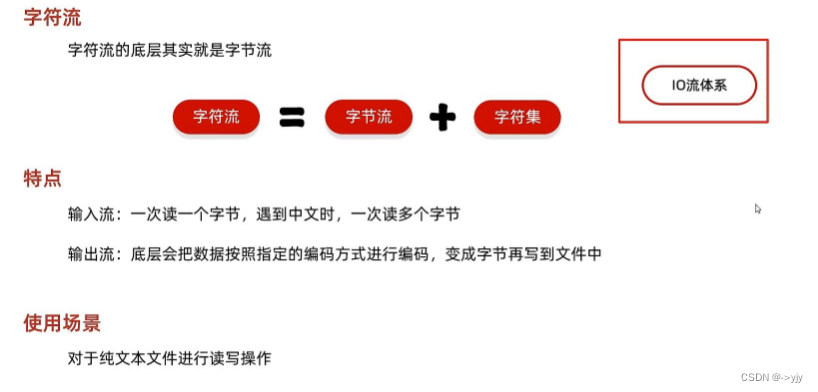


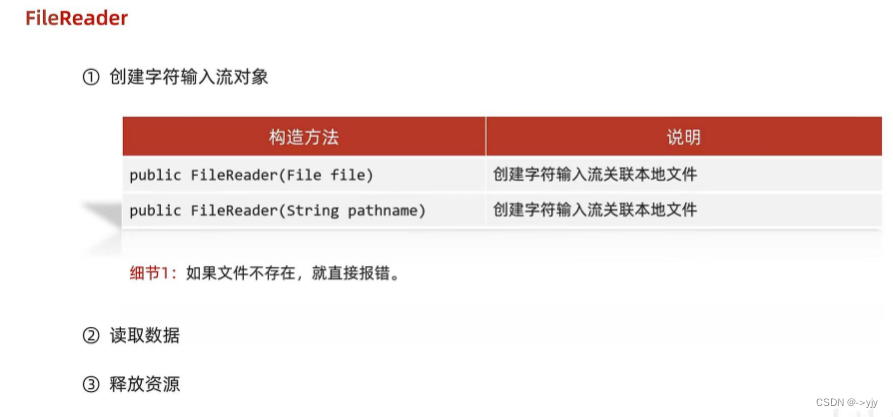
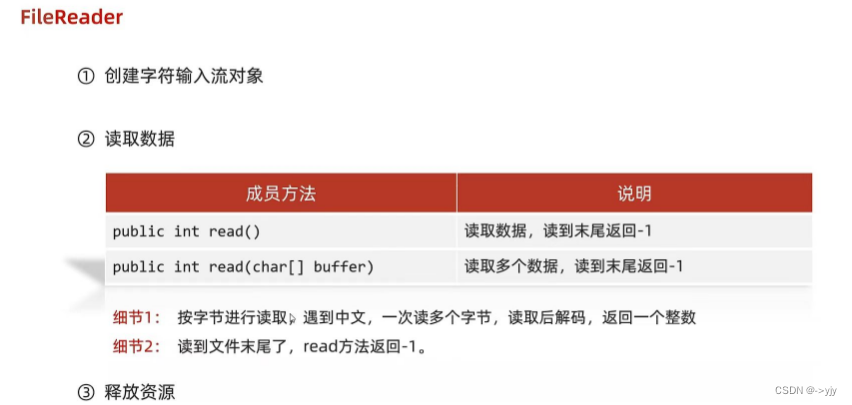
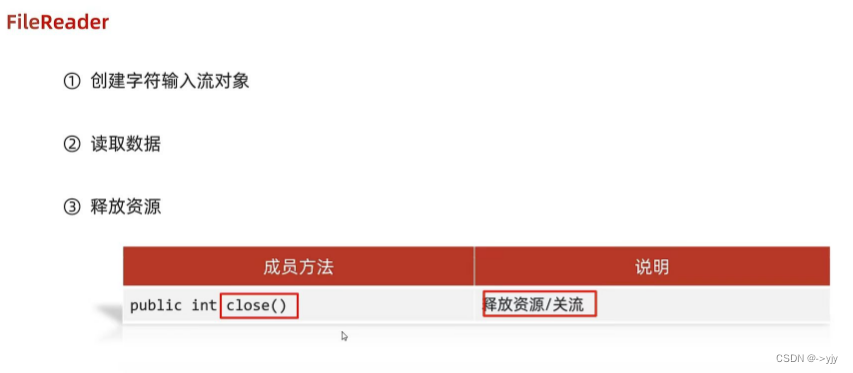
import java.io.FileReader;
import java.io.IOException;
public class Test {
public static void main(String[] args) throws IOException {
//1.创建对象并关联本地文件
FileReader fr = new FileReader("basic-code\\1.txt");
//2.读取数据 read()
//字符流的底层也是字节流,默认也是一个字节一个字节的读取的.
//如果遇到中文就会一次读取多个 GBK依次读两个字节,UTF-8一次读三个字节
//在读取之后 方法的底层还会进行解码并转成十进制
//最终把这个十进制作为返回值
//这个十进制的数据也表示在字符集上的数字
// 英文:文件里面二进制数据 0110 0001
//read方法进行获取a,解码并转成十进制97
//中文:文件里面的二进制数据 11100110 10110001 10001001
//read方法进行读取,解码并转成十进制27721
//我想看到中文汉字 就是把这些十进制数据 进行强转
int ch;
while((ch=fr.read())!=-1){
System.out.print((char)ch);
}
//释放资源
fr.close();
}
}
import java.io.FileReader;
import java.io.IOException;
public class Test {
public static void main(String[] args) throws IOException {
//1.创建对象
FileReader fr =new FileReader("basic-code\\1.txt");
//2.读取数据
char[] chars =new char[2];
int len;
//fr.read();//读取数据,解码,强转三步合并了,把强转之后的字符放到数组当中
//空参的read()+强制类型转换
while((len = fr.read(chars))!=-1){
//把数组中的数据变成字符串再进行打印
System.out.println(new String(chars,0,len));
}
//3.释放资源
fr.close();
}
}import java.io.FileOutputStream;
import java.io.FileWriter;
import java.io.IOException;
public class Test {
public static void main(String[] args) throws IOException {
//字节输出流:
FileOutputStream fos = new FileOutputStream("basic-code\\1.txt");
fos.write(97);//字节流 每次只能操作一个字节 255
fos.close();
//字符输出流:
FileWriter fw =new FileWriter("basic-code\\a.txt");
fw.write(7777);//根据字符集的编码方式进行编码 把编码之后的数据写到文件中去
fw.close();
FileWriter fw1= new FileWriter("basic-code\\1.txt",true);//续写开关
//fw1.write("你好");
char[] chars ={'a','b','c','我'};
fw.write(chars);
fw1.close();
}
}
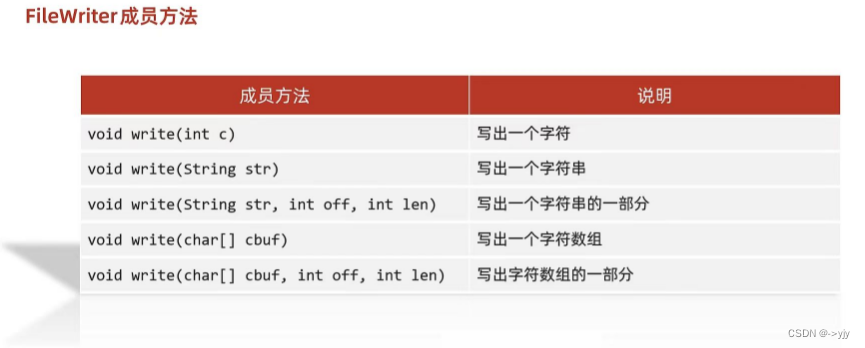
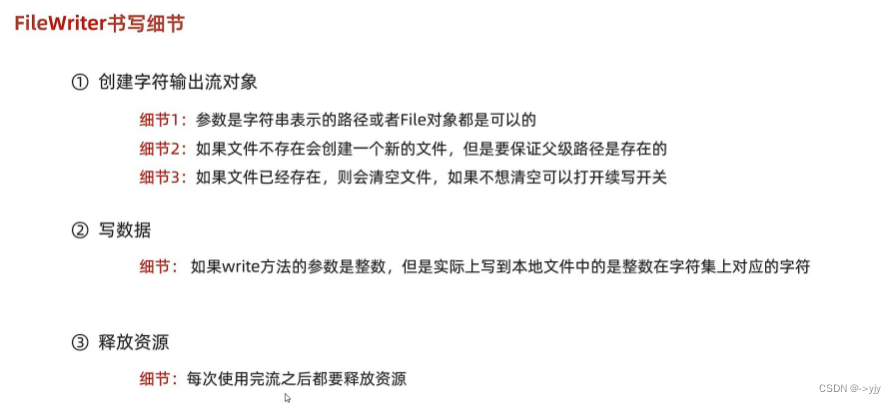
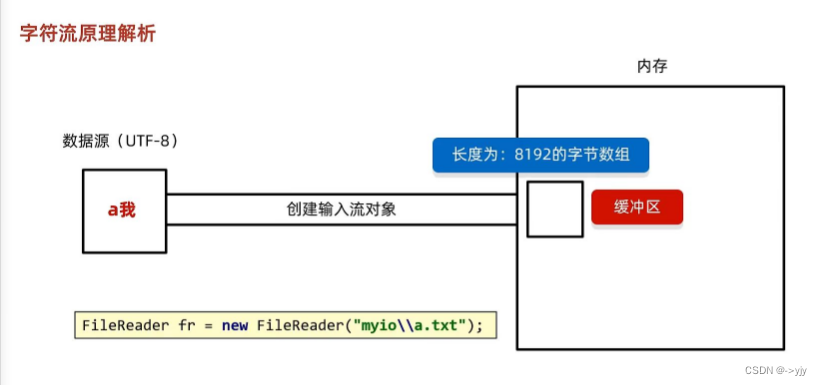


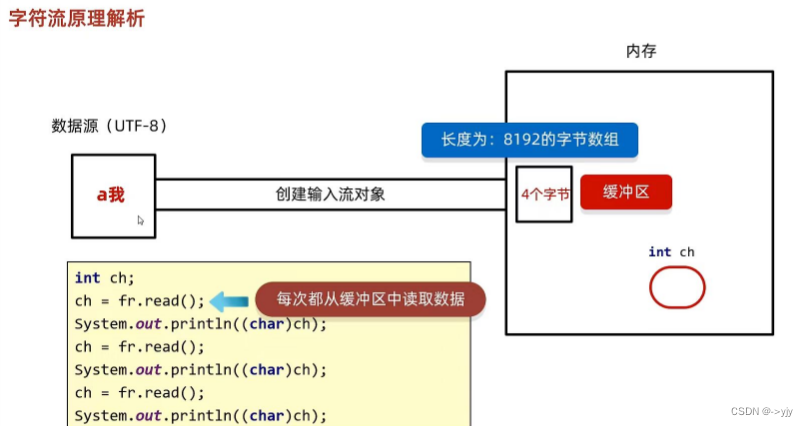

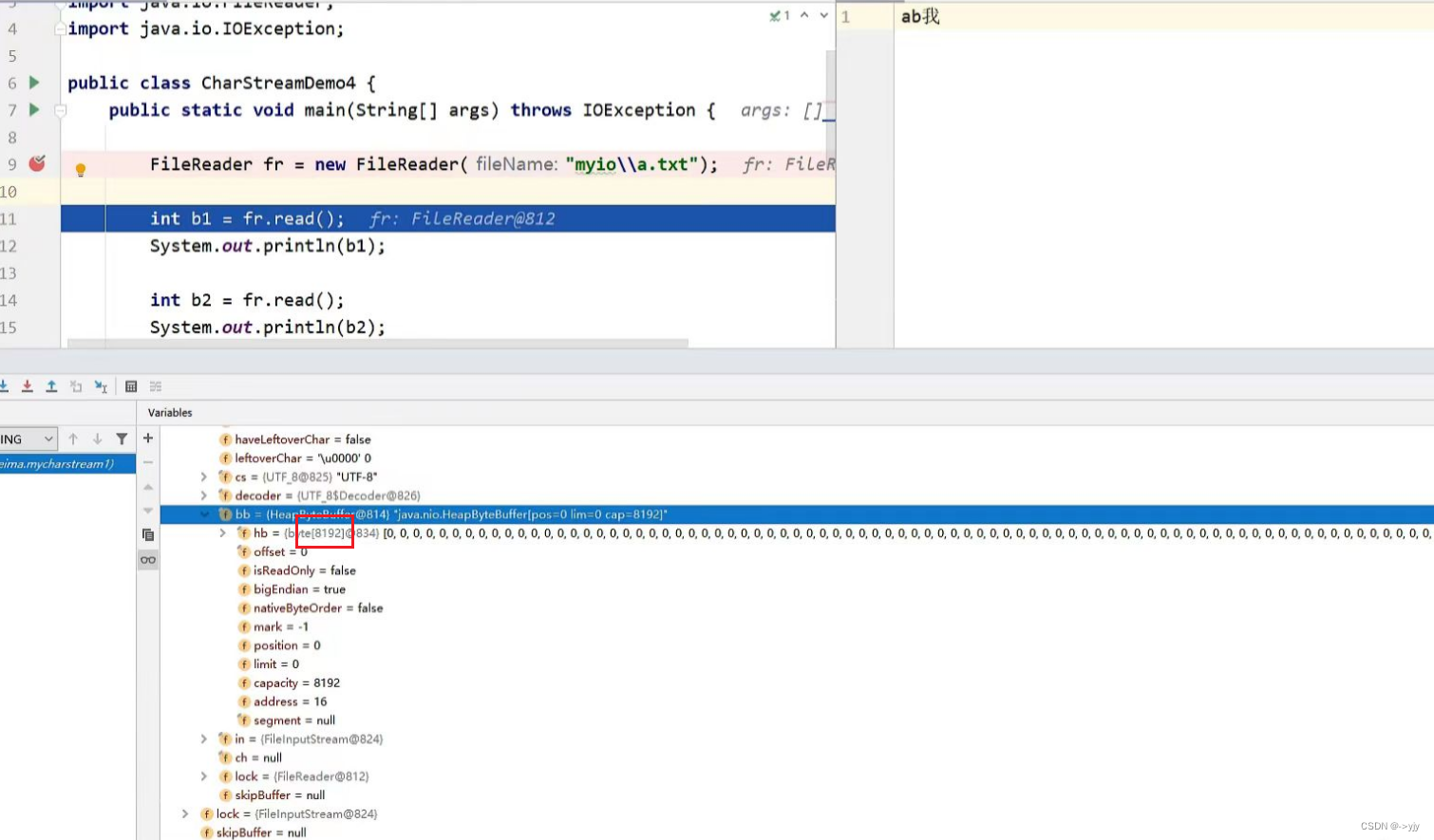

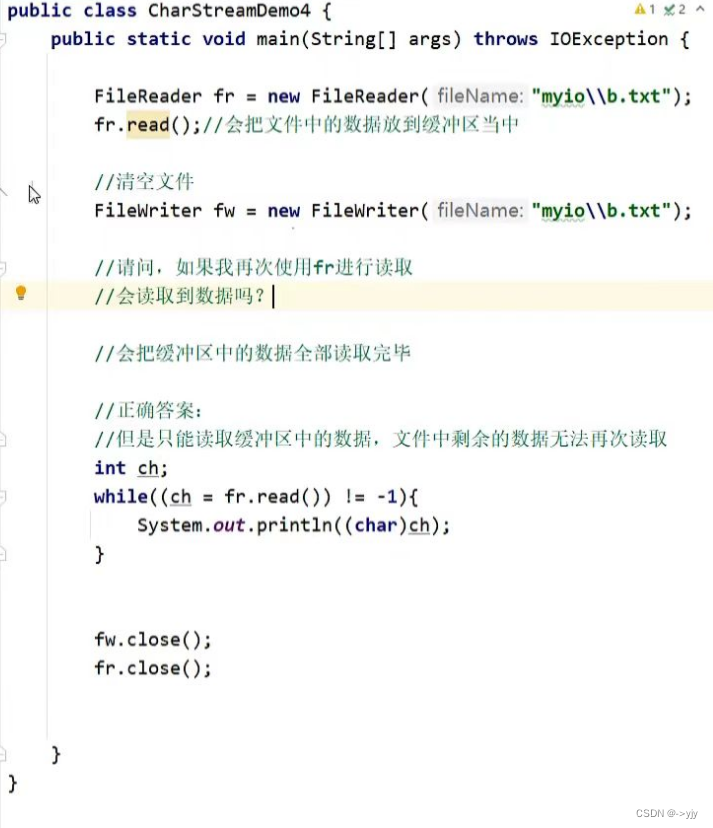
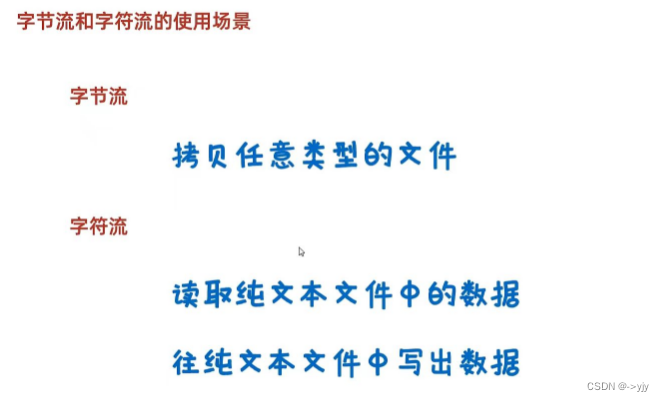

import java.io.File;
import java.io.FileInputStream;
import java.io.FileOutputStream;
import java.io.IOException;
public class Test {
public static void main(String[] args) throws IOException {
//拷贝文件夹 考虑子文件
//1.创建对象表示数据源
File src =new File("D:\\aaa\\src");
//2.创建对象表示目的地
File dest = new File("D:\\aaa\\dest");
//调用方法开始拷贝
copydir(src,dest);
}
/*
* 作用:拷贝文件夹
* 参数一:数据源
* 参数二:目的地
*
* */
private static void copydir(File src, File dest) throws IOException {
dest.mkdirs();
递归
//进入数据源
File[] files = src.listFiles();
//遍历数组
for (File file : files) {
if(file.isFile()){
//判断文件 拷贝
FileInputStream fis =new FileInputStream(file);
FileOutputStream fos =new FileOutputStream(new File(dest,file.getName()));
byte[] bytes = new byte[1024];
int len;
while((len=fis.read(bytes))!=-1){
fos.write(bytes,0,len);
}
fos.close();
fis.close();
}else{
//判断文件夹 递归
copydir(file,new File(dest,file.getName()));
}
}
}
}

//文件加密
//原始文件
FileInputStream fis =new FileInputStream("C:\\girl.jpg");
//加密处理
FileOutputStream fos =new FileOutputStream("C:\\ency.jpg");
//加密处理
int b;
while((b=fis.read())!=-1){
fos.write(b ^2);//随便异或一个数字
}
fos.close();
fis.close();
//这个程序操作完成后就可以将源文件删除了 这样别人也不知道是什么东西等到你想看了
//你再进行解密 //前置知识
/*
* ^:异或
* 两边相同:false
* 两边不同:true
* 0:false
* 1:true
*
* 100:110100
* 10:1010
*
* 1100100
* ^0001010
* ________________
* 1101110 --->110
* ^ 0001010
* ________________
* 1100100 --->100
* System.out.println(100^10);//110
* System.out.println(100^10^10);//100
*
* */
//文件加密
//原始文件
FileInputStream fis =new FileInputStream("C:\\ency.jpg");
//加密处理
FileOutputStream fos =new FileOutputStream("C:\\redu.jpg");
//加密处理
int b;
while((b=fis.read())!=-1){
fos.write(b ^2);//随便异或一个数字
}
fos.close();
fis.close();
//这个程序操作完成后就可以将源文件删除了 这样别人也不知道是什么东西等到你想看了
//你再进行解密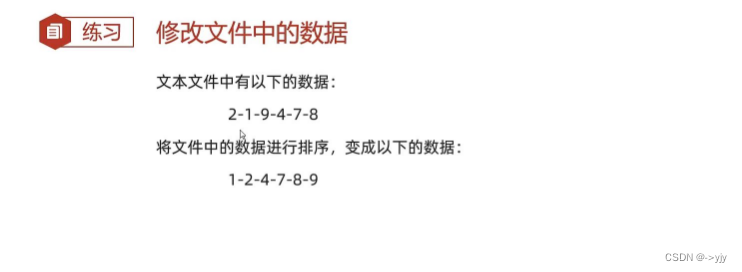
import java.io.FileReader;
import java.io.FileWriter;
import java.io.IOException;
import java.util.ArrayList;
import java.util.Collections;
public class Test {
public static void main(String[] args) throws IOException {
//修改文件中的数据
//1.读取数据
FileReader fr =new FileReader("basic-code\\a.txt");
StringBuilder sb =new StringBuilder();
int ch;
while((ch = fr.read())!=-1){
sb.append((char)ch);
}
fr.close();
System.out.println(sb);
//2.排序
String str =sb.toString();
String[] arrstr =str.split("-");
ArrayList<Integer>list = new ArrayList<>();
for (String s : arrstr) {
int i = Integer.parseInt(s);
list.add(i);
}
//System.out.println(list);
Collections.sort(list);
//3.写出
FileWriter fw =new FileWriter("basic-code\\a.txt");
for (int i = 0; i < list.size(); i++) {
if(i==list.size()-1){
fw.write(list.get(i)+"");//如果直接写数字 文件会变成ASCII码
}else{
fw.write(list.get(i)+"-");
}
}
fw.close();
}
}import java.io.FileReader;
import java.io.FileWriter;
import java.io.IOException;
import java.util.Arrays;
//细节:文件中的数据不要换行 如果加了换行会有\r\n 读取也会读到
//bom头---占三个字节 编码改为ANSI
public class Test {
public static void main(String[] args) throws IOException {
//修改文件中的数据
//1.读取数据
FileReader fr =new FileReader("basic-code\\a.txt");
StringBuilder sb =new StringBuilder();
int ch;
while((ch = fr.read())!=-1){
sb.append((char)ch);
}
fr.close();
System.out.println(sb);
//2.排序
Integer[] arr = Arrays.stream(sb.toString().split("-"))
.map(Integer::parseInt)
.sorted()
.toArray(Integer[]::new);
//System.out.println(arr);
//3.写出
FileWriter fw = new FileWriter("C:\\yjy");
String s = Arrays.toString(arr).replace(", ","-");
String result = s.substring(1,s.length()-1);
//System.out.println(result);
fw.write(result);
fw.close();
}
}

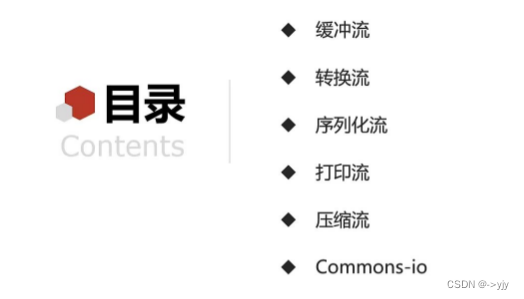
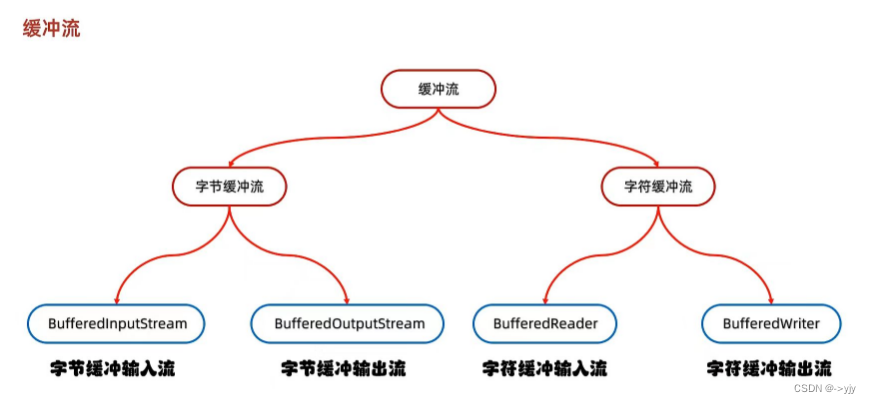
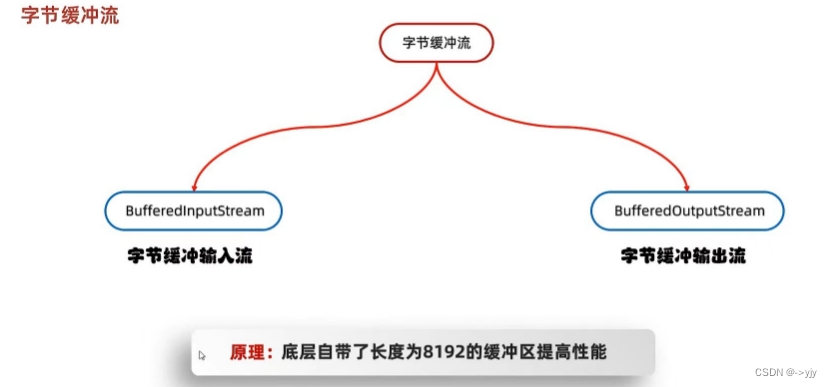
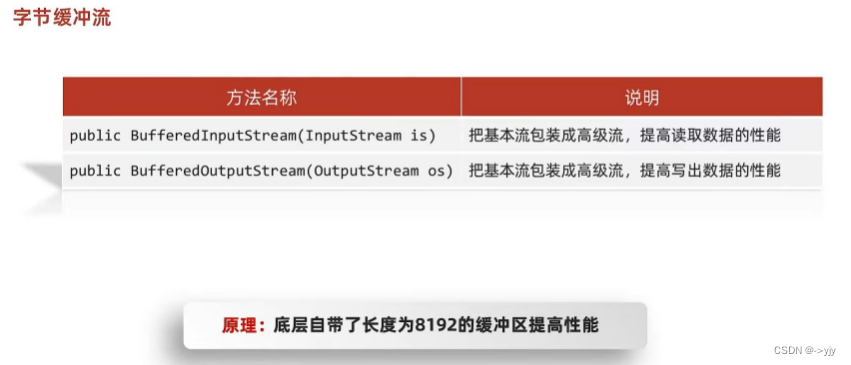

public class Test {
public static void main(String[] args) throws IOException {
//1.创建缓冲流的对象
BufferedInputStream bis = new BufferedInputStream(new FileInputStream("basic-code\\a.txt"));
BufferedOutputStream bos = new BufferedOutputStream(new FileOutputStream("basic-code\\1.txt"));
//2.循环读取
int b;
while ((b = bis.read()) != -1) {
bos.write(b);
}
//3.释放资源
bos.close();
bis.close();
}
}public class Test {
public static void main(String[] args) throws IOException {
//一次读写一个字节数组
BufferedInputStream bis = new BufferedInputStream(new FileInputStream("basic-code\\a.txt"));
BufferedOutputStream bos =new BufferedOutputStream(new FileOutputStream("basic-code\\b.txt"));
byte[] bytes =new byte[1024];
int len;
while((len=bis.read(bytes))!=-1){
bos.write(bytes,0,len);
}
bos.close();
bis.close();
}
}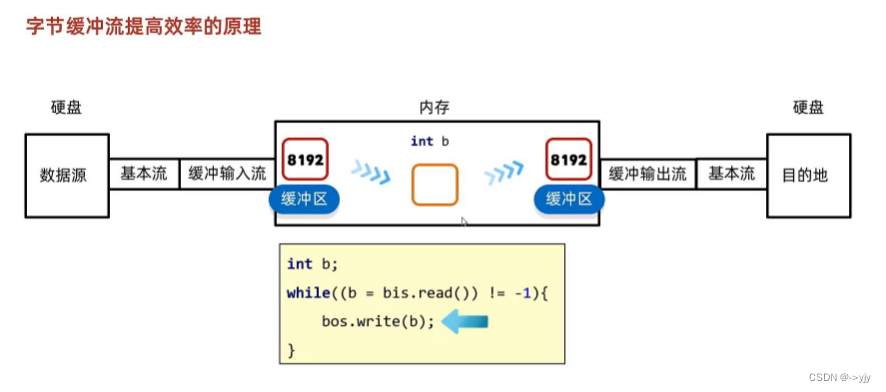

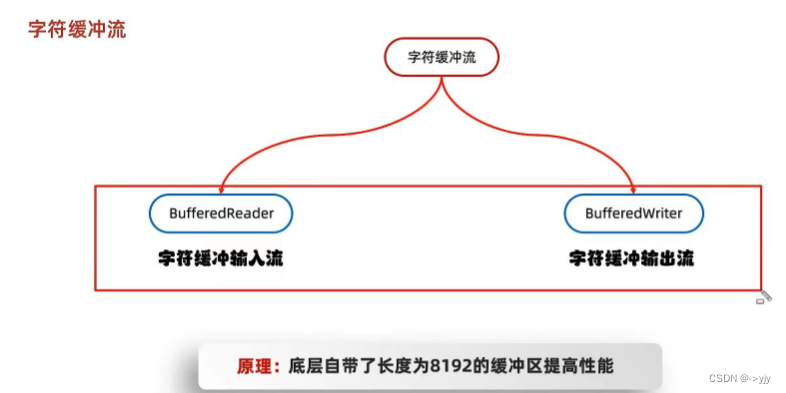
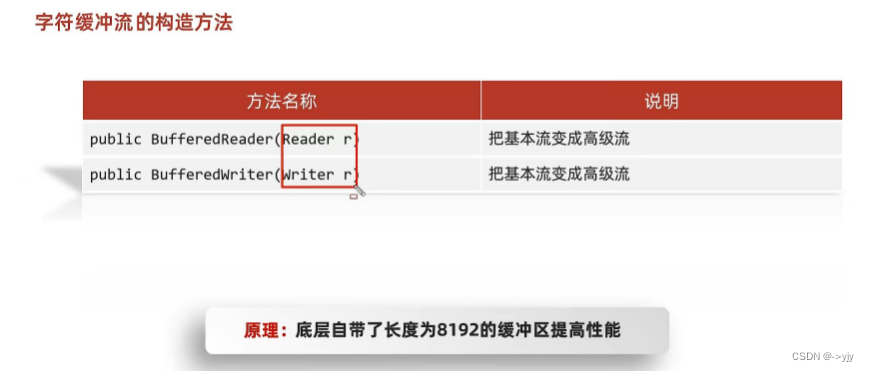

import java.io.BufferedReader;
import java.io.FileReader;
import java.io.IOException;
public class Test {
public static void main(String[] args) throws IOException {
//两个缓冲区之间这不也是一个字节一个字节的进行倒手的吗?? 速度为什么快了?
//因为这一段是在内存中运行的速度非常的快
/*字符缓冲输入流:
* 构造方法:public BufferedReader(Reader r)
* 特有方法:public String readLine() 读一整行*/
//readLine 方法在读取的时候 一次读一整行 遇到空格换行结束
//但是他不会把回车读到内存当中
//1.创建字符缓冲输入流的对象
BufferedReader br =new BufferedReader(new FileReader("basic-code\\1.txt"));
//2.读取数据
// String line = br.readLine();
// System.out.println(line);
String line;
while((line=br.readLine())!=null){
System.out.println(line);
}
//释放资源
br.close();
}
}public class Test {
public static void main(String[] args) throws IOException {
/*字符缓冲输出流
* 构造方法:public BufferedWriter(writer r)
* 特有方法:public void newLine() 跨平台换行*/
//1.创建字符缓冲输出流的对象
BufferedWriter bw =new BufferedWriter(new FileWriter("b.txt"));
//2.写出数据
bw.write("你嘴角上扬的样子,百度搜索不到");
bw.newLine();
bw.write("以后我结婚你一定要来 ,没有新娘我会很尴尬");
//3.释放资源
bw.close();
}
}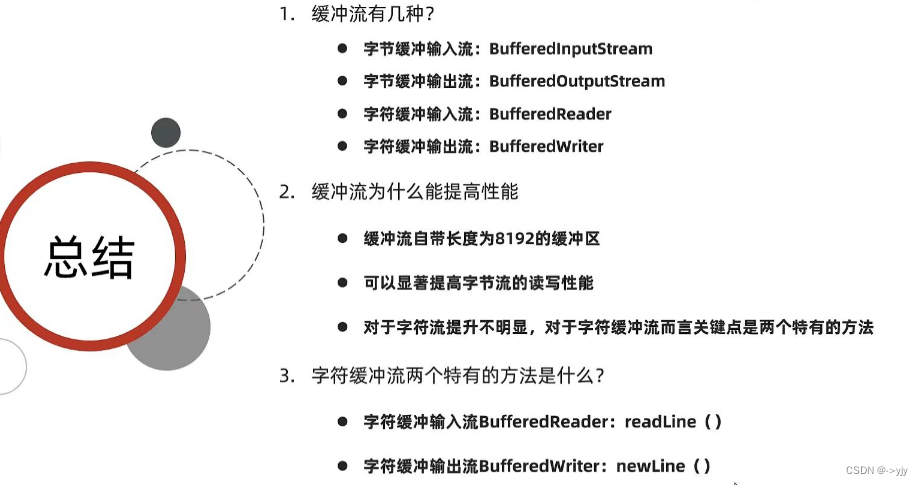
import java.io.*;
public class Test {
public static void main(String[] args) throws IOException {
//拷贝文件
//四种方法拷贝文件,并统计各自用时
//字节流的基本流:依次读写一个字节
//字节流的基本流:一次读写一个字节数组
//字节缓冲流:一次读写一个字节
//字节缓冲流:一次读写一个字节数组
long start = System.currentTimeMillis();
method1();
method2();//16
method3();//95
method4();//17
long end=System.currentTimeMillis();
System.out.println((end-start)/1000.0+"秒");
}
private static void method3() throws IOException {
//字节缓冲流
BufferedInputStream bis =new BufferedInputStream(new FileInputStream("1.txt"));
BufferedOutputStream bos =new BufferedOutputStream(new FileOutputStream("2.txt"));
int b;
while((b=bis.read())!=-1){
bos.write(b);
}
bos.close();
bis.close();
}
private static void method4() throws IOException {
BufferedInputStream bis = new BufferedInputStream(new FileInputStream("1.txt"));
BufferedOutputStream bos = new BufferedOutputStream(new FileOutputStream("2.txt"));
byte[] bytes = new byte[8192];
int len;
while ((len = bis.read(bytes)) != -1) {
bos.write(bytes,0,len);
}
bos.close();
bis.close();
}
private static void method2() throws IOException {
FileInputStream fis = new FileInputStream("C:\\1.txt");
FileOutputStream fos=new FileOutputStream("1.txt");
byte[] bytes= new byte[1024];
int len;
while((len=fis.read(bytes))!=-1){
fos.write(bytes,0,len);
}
fos.close();
fis.close();
}
private static void method1() throws IOException {
FileInputStream fis = new FileInputStream("C:\\1.txt");
FileOutputStream fos = new FileOutputStream("1.txt");
int b;
while ((b = fis.read()) != -1) {
fos.write(b);
}
fos.close();
fis.close();
}
}
import java.io.*;
import java.util.ArrayList;
import java.util.Collections;
import java.util.Comparator;
public class Test {
public static void main(String[] args) throws IOException {
//需求:把<出师表>的文章顺序进行恢复到一个新文件中
//1.读取数据
BufferedReader br =new BufferedReader(new FileReader("basic-code"));
String line;
ArrayList<String>list=new ArrayList<>();
while((line=br.readLine())!=null){
// System.out.println(line);
list.add(line);
}
br.close();
//2.排序
//排序规则:按照每一行前面的序号进行排序
Collections.sort(list, new Comparator<String>() {
@Override
public int compare(String o1, String o2) {
//获取o1,o2的序号
int i = Integer.parseInt(o1.split("\\.")[0]);
int i1 = Integer.parseInt(o2.split("\\.")[0]);
return i-i1;
}
});
//写出
BufferedWriter bw =new BufferedWriter(new FileWriter("1.txt"));
for (String s : list) {
bw.write(s);
bw.newLine();
}
bw.close();
}
}import java.io.*;
import java.util.Map;
import java.util.Set;
import java.util.TreeMap;
public class Test {
public static void main(String[] args) throws IOException {
//需求:把<出师表>的文章顺序进行恢复到一个新文件中
BufferedReader br =new BufferedReader(new FileReader("1.txt"));
String line;
TreeMap<Integer,String> tm = new TreeMap<>();
while((line=br.readLine())!=null){
String[] arr =line.split("\\.");
//0:序号 1:内容
tm.put(Integer.parseInt(arr[0]),line);
}
br.close();
//System.out.println(tm);
//2.写出数据
BufferedWriter bw =new BufferedWriter(new FileWriter("basic-code"));
Set<Map.Entry<Integer,String>>entries = tm.entrySet();
for(Map.Entry<Integer,String>entry:entries){
String value = entry.getValue();
bw.write(value);
bw.newLine();
}
bw.close();
}
} 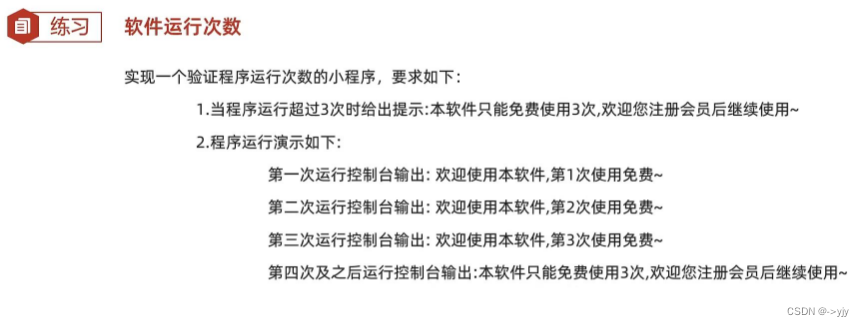
import java.io.*;
public class Test {
public static void main(String[] args) throws IOException {
//能用计数器的知识来做吗?不能 因为变量创建在内存中 程序重启 又能够再来三次
//为了永久化存储所以要保存在文件当中
//1.把文件中的数字读取到内存中
//一次读一行 而不是读一个
BufferedReader br =new BufferedReader(new FileReader("basic-code"));
String line =br.readLine();
int count = Integer.parseInt(line);
//表示当前软件又运行了一次
count++;
//2.判断
if(count<=3){
System.out.println("欢迎使用本软件,第"+count+"次免费使用");
}else{
System.out.println("本软件只能使用三次,请注册会员继续使用");
}
//<=3:正常运行
//>3:不能运行
//3.把自增之后的count写出到文件当中
BufferedWriter bw = new BufferedWriter(new FileWriter("basic-code"));
//缓冲区输出流在关联文件的时候,文件存在就会清空
//原则:IO:随用随创建
//什么时候不用就关掉
bw.write(count+"");//97 a
bw.close();
}
}
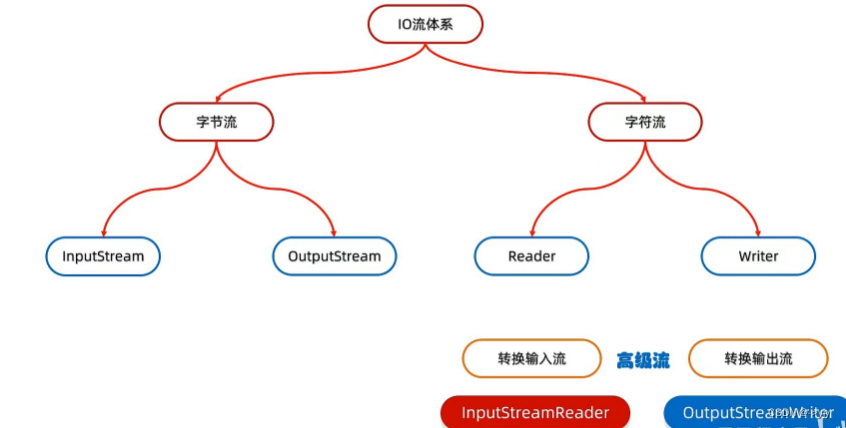
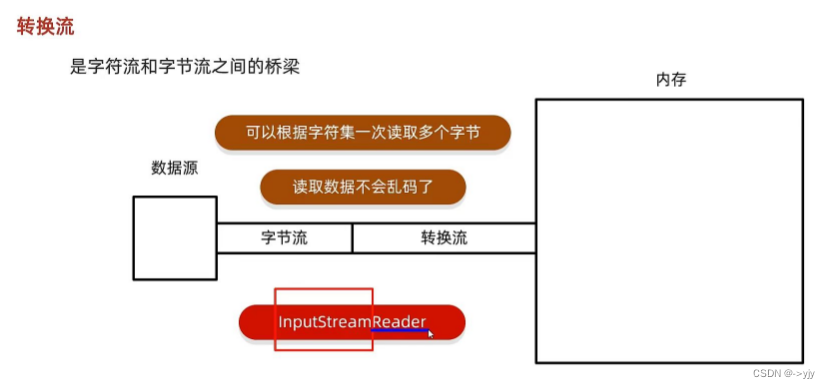
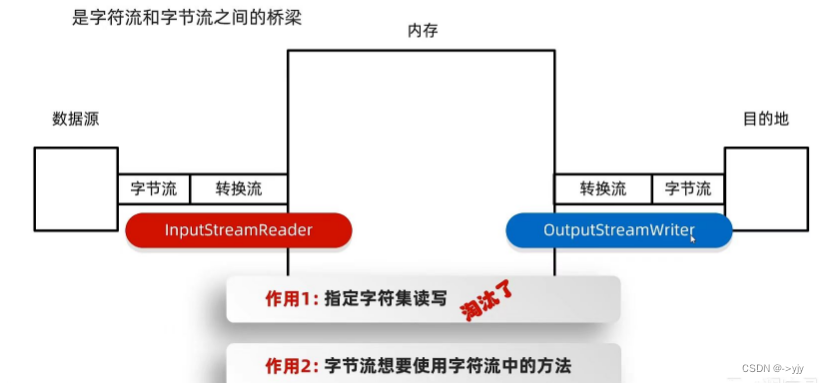
import java.io.*;
import java.nio.charset.Charset;
public class Test {
public static void main(String[] args) throws IOException {
//利用转换流按照指定字符编码读取(了解)
/*
* 因为JDK11:这种方法被淘汰了 --->替代方案(掌握)*/
// //1.创建对象并指定字符编码(了解即可)
// InputStreamReader isr =new InputStreamReader(new FileInputStream("basic-code"),"GBK");
// //2.读取数据
// int ch;
// while((ch=isr.read())!=-1){
// System.out.println((char)ch);
// }
// //3.释放资源
// isr.close();
//掌握
FileReader fr = new FileReader("basic-code", Charset.forName("GBK"));
// 2.读取数据
int ch;
while((ch=fr.read())!=-1){
System.out.println((char)ch);
}
//3.释放资源
fr.close();
}
}
import java.io.FileWriter;
import java.io.IOException;
import java.nio.charset.Charset;
public class Test {
public static void main(String[] args) throws IOException {
//利用转换流按照指定字符编码写出(了解)
// //1.创建转换流对象
// OutputStreamWriter osw =new OutputStreamWriter(new FileOutputStream("basic-code"),"GBK");
// //2.写出数据
// osw.write("你好你好");
// //3.释放资源
// osw.close();
//替代方案
FileWriter fw = new FileWriter("basic-code", Charset.forName("GBK"));
fw.write("你好你好");
fw.close();
}
}
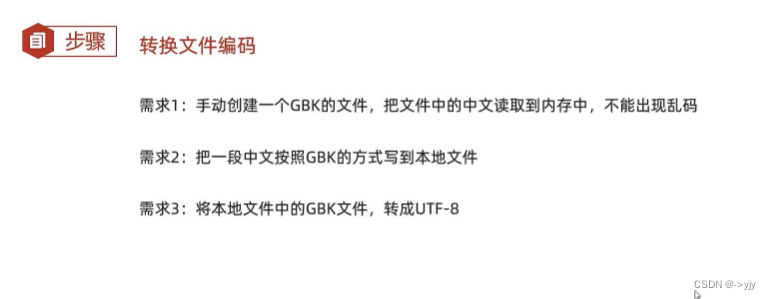

import java.io.*;
import java.nio.charset.Charset;
public class Test {
public static void main(String[] args) throws IOException {
//将本地文件中GBK文件 转成UTF-8
//1.JDK以前的方案
InputStreamReader isr = new InputStreamReader(new FileInputStream("basic-code"),"GBK");
OutputStreamWriter osw =new OutputStreamWriter(new FileOutputStream("basic-code1"),"UTF-8");
int b;
while ((b= isr.read())!=-1){
osw.write(b);
}
osw.close();
isr.close();
//替代方案
FileReader fr =new FileReader("basic-code", Charset.forName("GBK"));
FileWriter fw =new FileWriter("basic-code1",Charset.forName("UTF-8"));
int b;
while((b=fr.read())!=-1){
fw.write(b);
}
fw.close();
fr.close();
}
}
import java.io.BufferedReader;
import java.io.FileInputStream;
import java.io.IOException;
import java.io.InputStreamReader;
public class Test {
public static void main(String[] args) throws IOException {
//利用字节流读取文件中的数据 每次读一整行,而且不能出现乱码
//1.字节流在读取中文的时候,是会出现乱码的,但是字符流可以搞定
//2.字节流里面没有读一整行的方法的 只有字符缓冲流可以搞定
// FileInputStream fis= new FileInputStream("basic-code");
// InputStreamReader isr =new InputStreamReader(fis);
//
// BufferedReader br =new BufferedReader(isr);
// String s = br.readLine();
// br.close();
BufferedReader br =new BufferedReader(new InputStreamReader(new FileInputStream("yjy.txt")));
String line;
while((line=br.readLine())!=null){
System.out.println(line);
}
br.close();
}
}
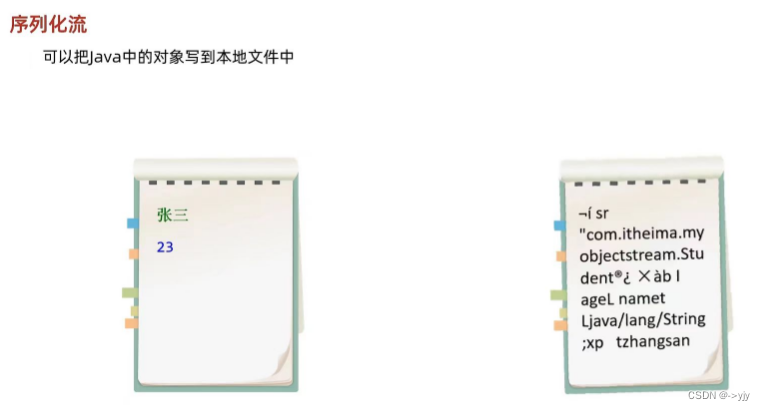
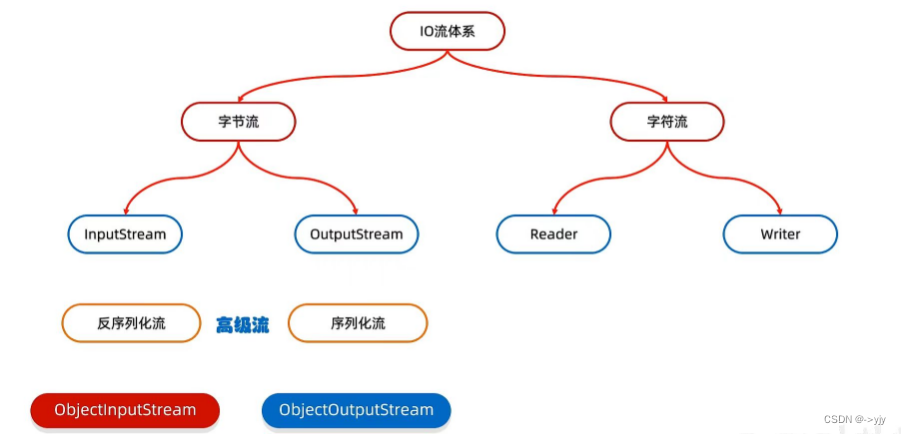
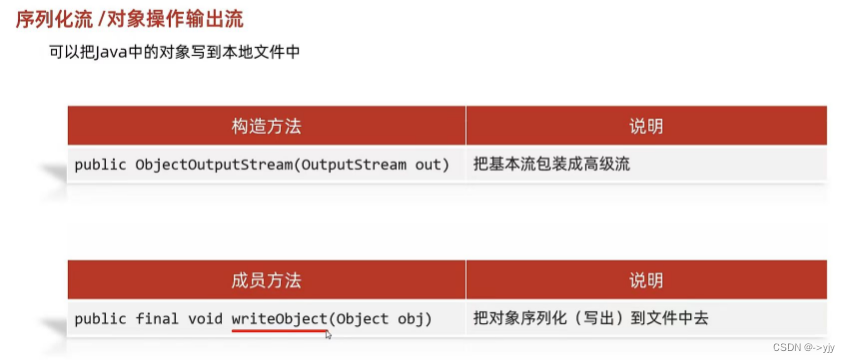

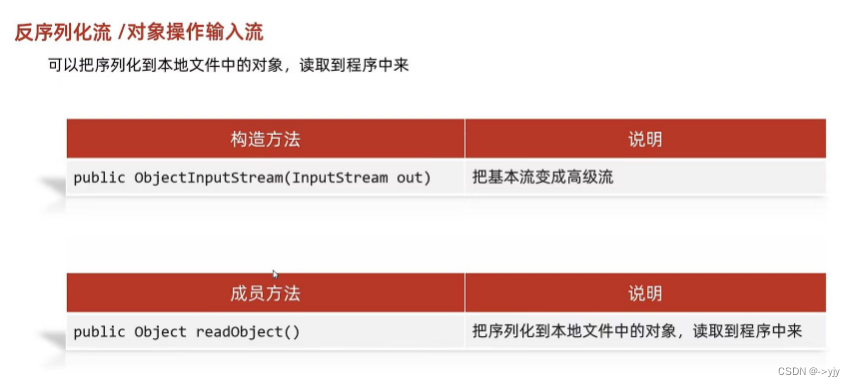
import java.io.FileOutputStream;
import java.io.IOException;
import java.io.ObjectOutputStream;
public class Test {
public static void main(String[] args) throws IOException {
/*
* serializable接口里面没有抽象方法,标记型接口
* 一旦实现了这个接口 那么就表示当前的student类可以被序列化
* 理解:
* 一个物品的合格证
* */
//序列化流
Student stu =new Student("zhangsan",23);
ObjectOutputStream oos =new ObjectOutputStream(new FileOutputStream("basic-code\\a.txt"));
oos.writeObject(stu);
oos.close();
}
}
import java.io.Serializable;
public class Student implements Serializable {
private String name;
private int age;
public Student() {
}
public Student(String name, int age) {
this.name = name;
this.age = age;
}
/**
* 获取
* @return name
*/
public String getName() {
return name;
}
/**
* 设置
* @param name
*/
public void setName(String name) {
this.name = name;
}
/**
* 获取
* @return age
*/
public int getAge() {
return age;
}
/**
* 设置
* @param age
*/
public void setAge(int age) {
this.age = age;
}
public String toString() {
return "Student{name = " + name + ", age = " + age + "}";
}
}
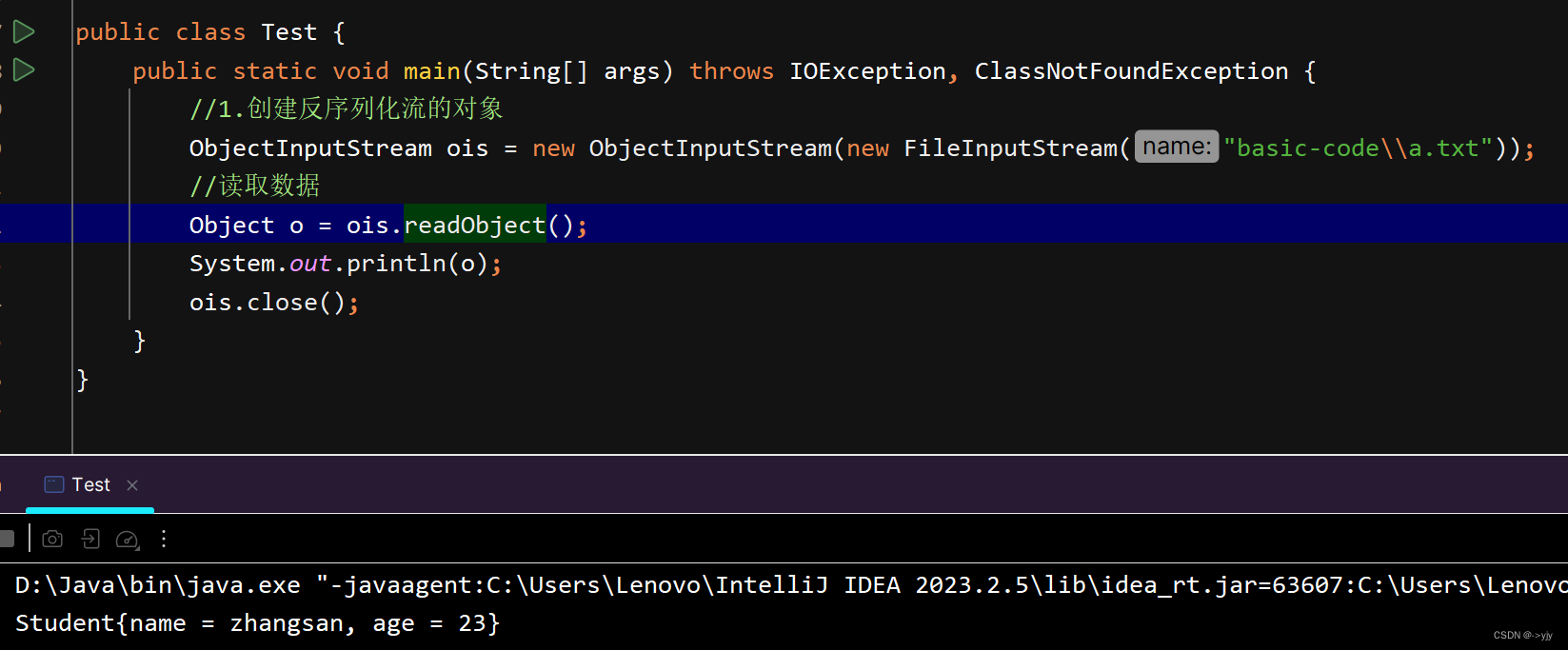
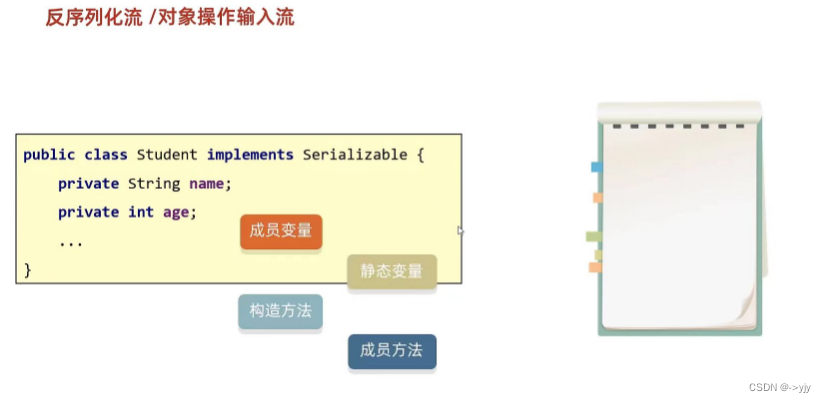
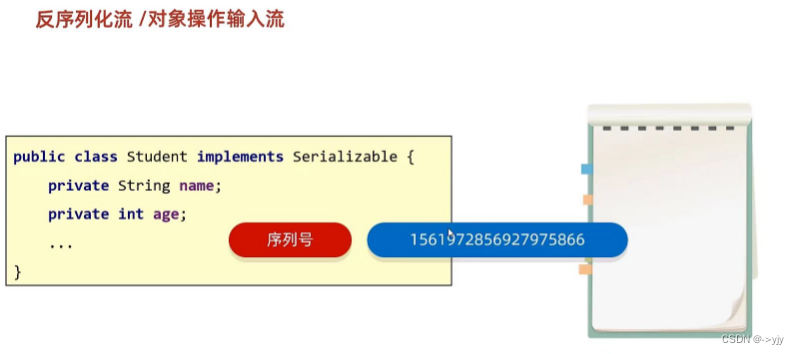
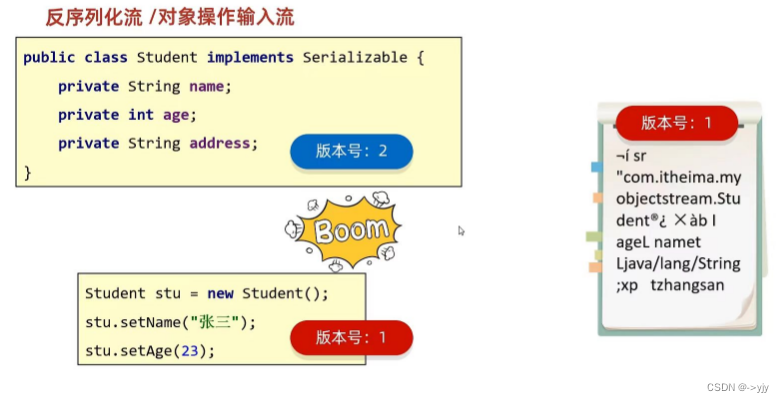

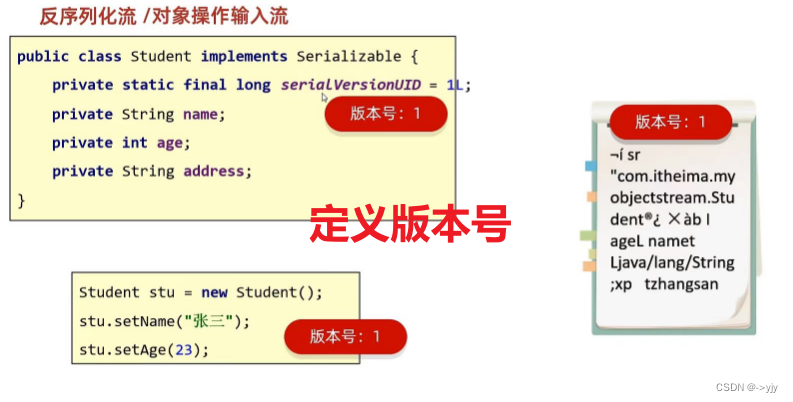
自己设置一个提示-版本号
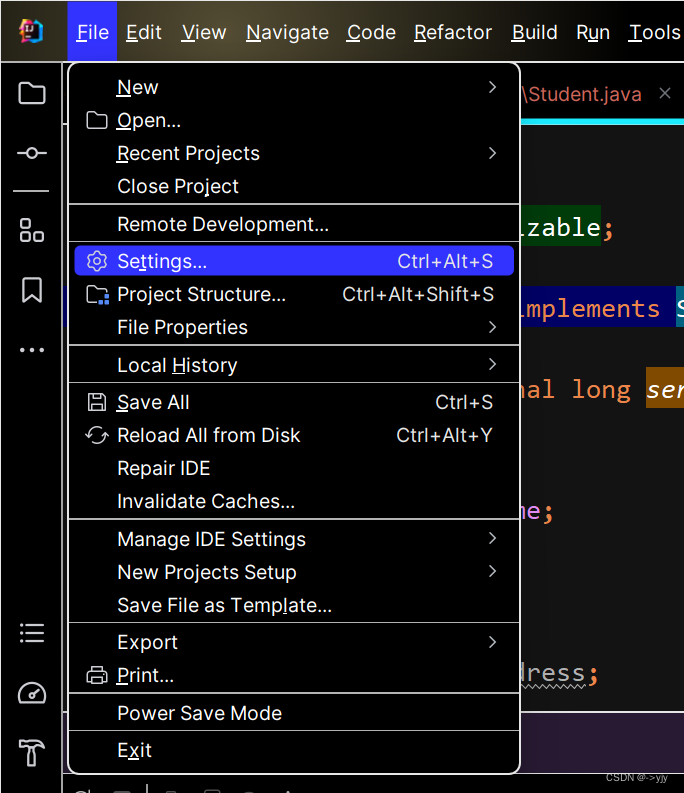
在搜索框搜索Serializable
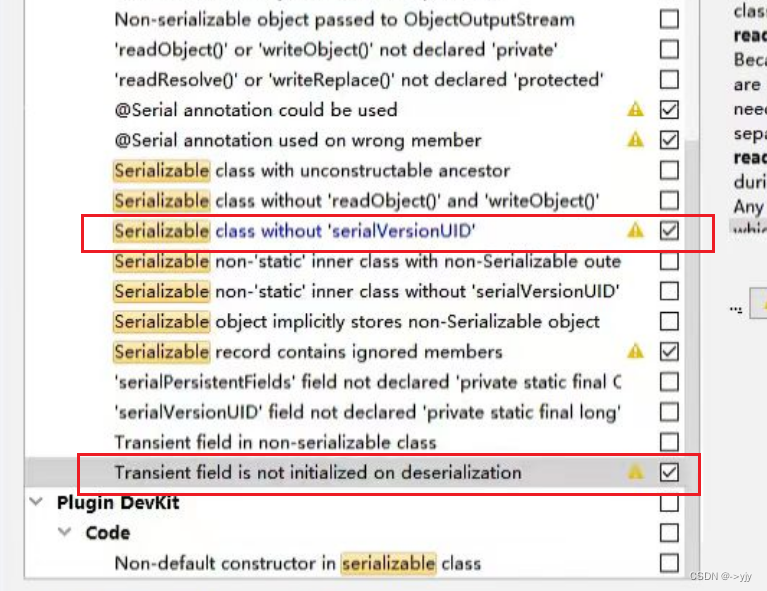
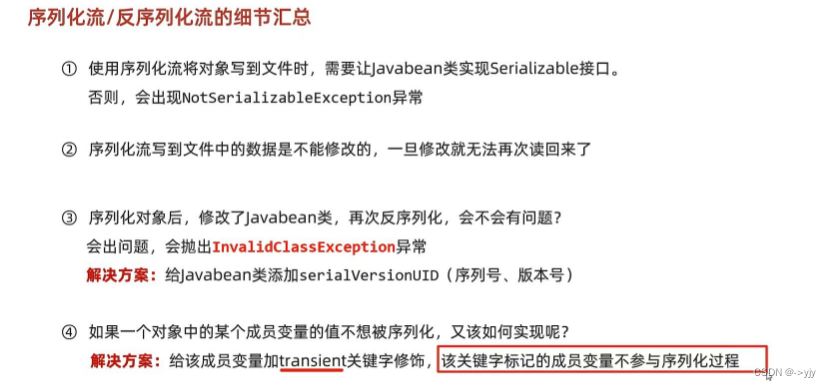
public class Student implements Serializable {
@Serial
private static final long serialVersionUID = 5498121245996411513L;
// private static final long serialVersionUID = 1L;
private String name;
private int age;
private String address;
public Student() {
}
public Student(String name, int age) {
this.name = name;
this.age = age;
}
/**
* 获取
* @return name
*/
public String getName() {
return name;
}
/**
* 设置
* @param name
*/
public void setName(String name) {
this.name = name;
}
/**
* 获取
* @return age
*/
public int getAge() {
return age;
}
/**
* 设置
* @param age
*/
public void setAge(int age) {
this.age = age;
}
public String toString() {
return "Student{name = " + name + ", age = " + age + "}";
}
}
import java.io.FileOutputStream;
import java.io.IOException;
import java.io.ObjectOutputStream;
import java.util.ArrayList;
public class Test {
public static void main(String[] args) throws IOException, ClassNotFoundException {
///用对象流读写多个对象
//需求:
//将多个自定义对象序列化到文件中,但是由于对象的个数不确定,反序列化流该如何读取呢?
Student s1 =new Student("zhangsan",23,"南京");
Student s2 =new Student("lisi",24,"重庆");
Student s3 =new Student("wangwu",25,"北京");
//序列化多个对象
ArrayList<Student>list =new ArrayList<>();
list.add(s1);
list.add(s2);
list.add(s3);
ObjectOutputStream oos =new ObjectOutputStream(new FileOutputStream("basic-code"));
oos.writeObject(list);
oos.close();
}
}
import java.io.FileInputStream;
import java.io.IOException;
import java.io.ObjectInputStream;
import java.util.ArrayList;
public class Demo {
public static void main(String[] args) throws IOException, ClassNotFoundException {
//反序列化流的对象
ObjectInputStream ois = new ObjectInputStream(new FileInputStream("basic-code"));
//
// Student s1 = (Student) ois.readObject();
// Student s2 = (Student) ois.readObject();
// Student s3 = (Student) ois.readObject();
ArrayList<Student>list = (ArrayList<Student>) ois.readObject();
for (Student student : list) {
System.out.println(student);
}
ois.close();
}
}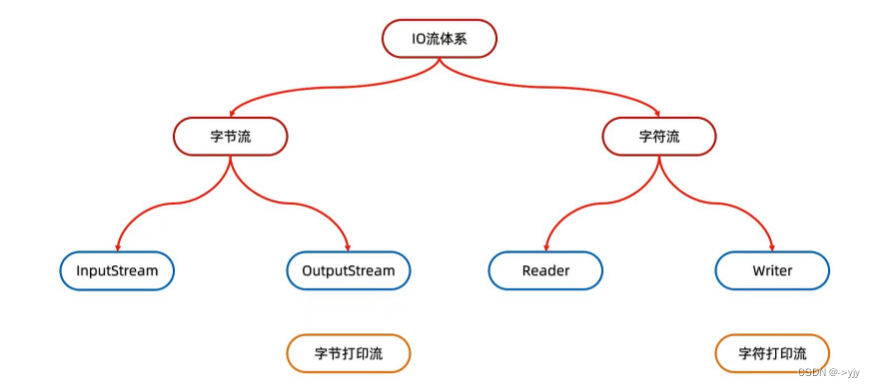
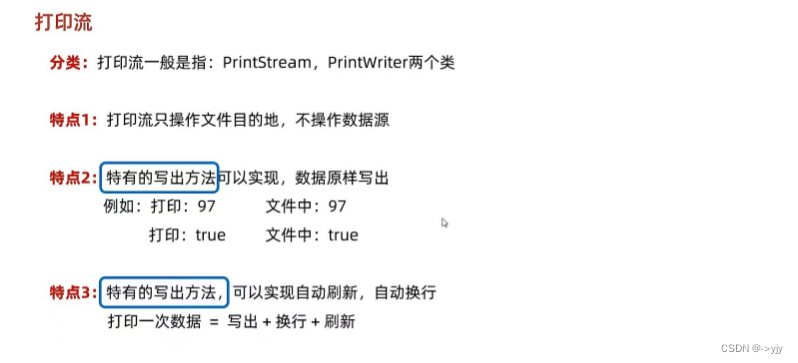
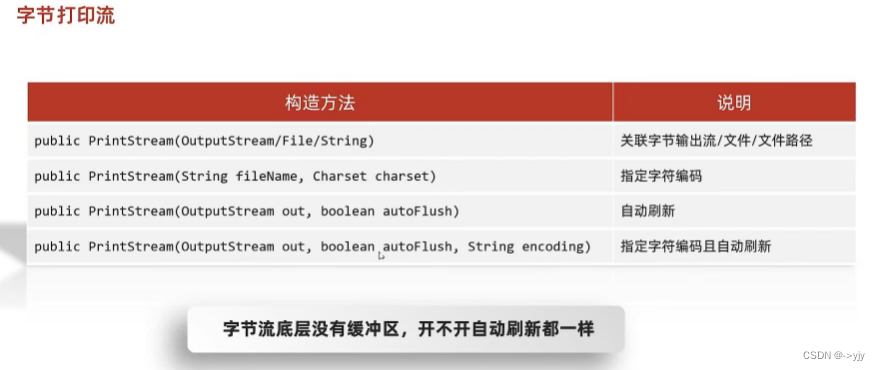

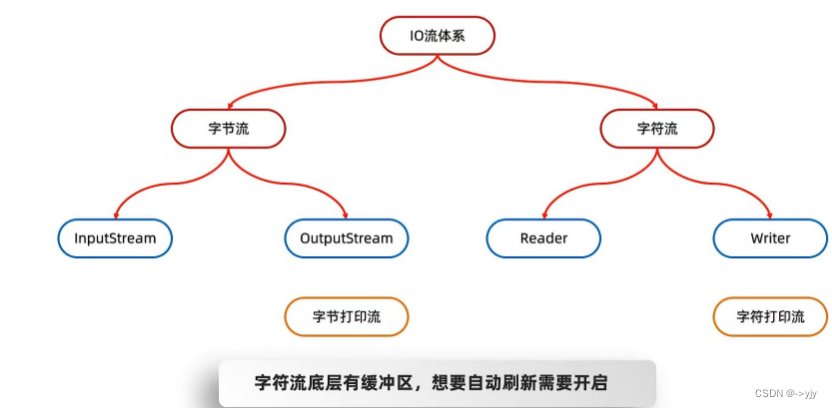
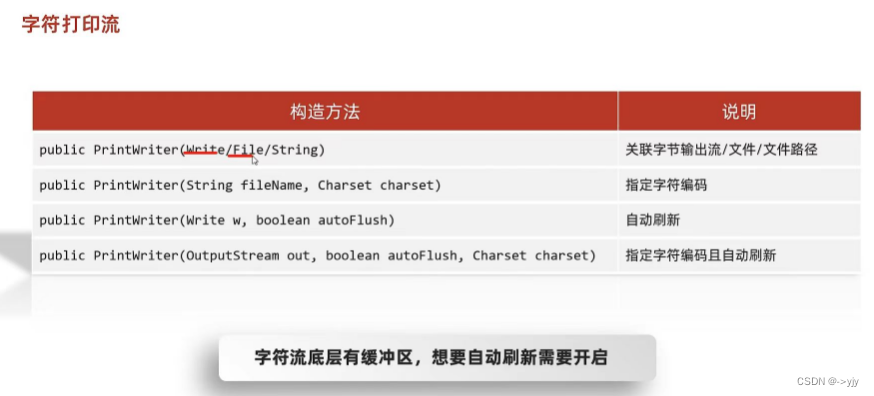
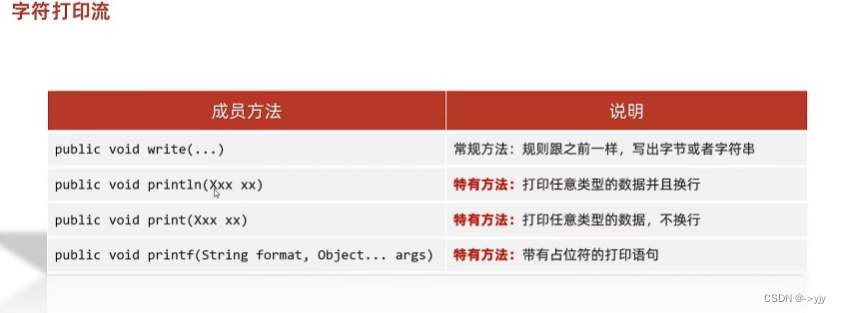

import java.io.FileOutputStream;
import java.io.IOException;
import java.io.PrintStream;
import java.nio.charset.Charset;
public class Test {
public static void main(String[] args) throws IOException, ClassNotFoundException {
//打印流
//1.创建字节打印流的对象
PrintStream ps =new PrintStream(new FileOutputStream("myio\\1.txt"),true, Charset.forName("UTF-8"));
//2.写出数据
ps.println(97);//写出+自动刷新+自动换行
ps.print(true);
ps.println();
ps.printf("%s 爱上了 %s","阿珍","阿强");
//3.释放资源
ps.close();
}
}public class Test {
public static void main(String[] args) throws IOException, ClassNotFoundException {
//打印流
//1.创建字符打印流
PrintWriter pw =new PrintWriter(new FileWriter("basic-code"),true);
pw.println("dhuaidhwahdo");
pw.print("你好你好");
pw.close();
}
}解压缩流/压缩流
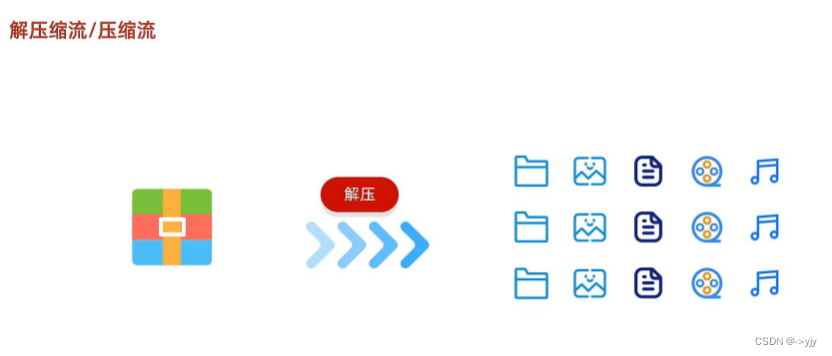
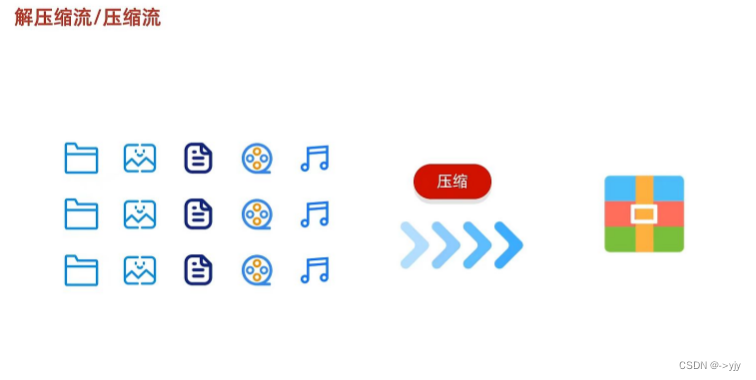
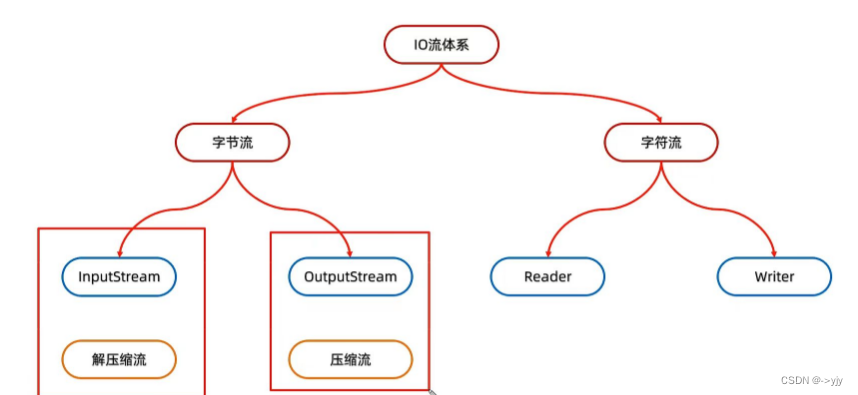
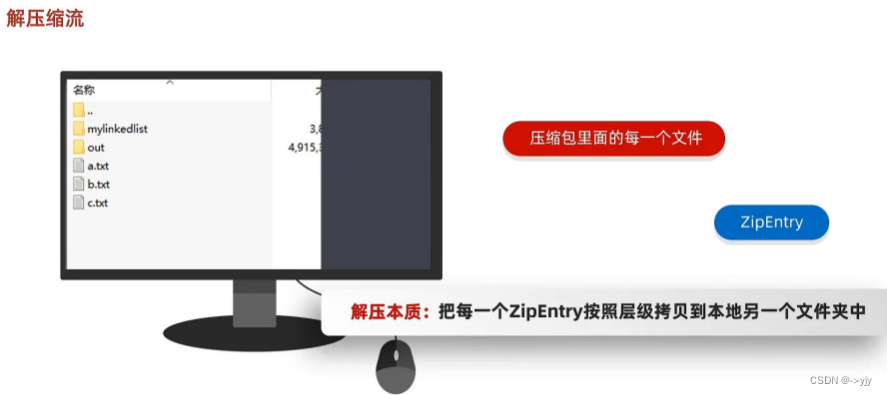
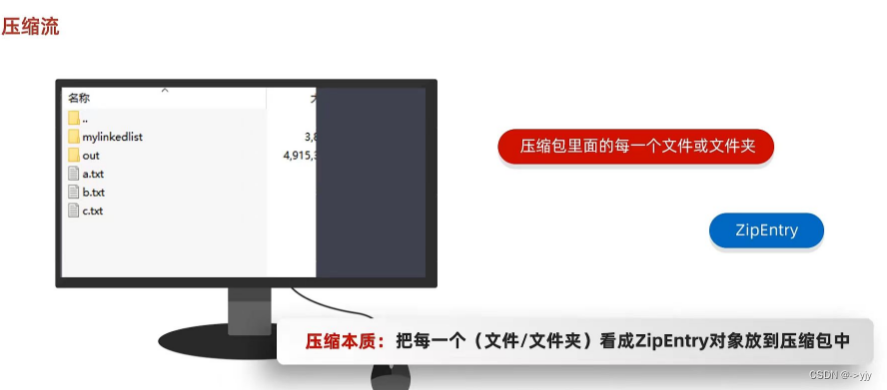
import java.io.File;
import java.io.FileInputStream;
import java.io.FileOutputStream;
import java.io.IOException;
import java.util.zip.ZipEntry;
import java.util.zip.ZipInputStream;
public class Test {
public static void main(String[] args) throws IOException, ClassNotFoundException {
//1.创建一个File表示要解压的压缩包
File src =new File("D:\\aaa.zip");
//2.创建File对象表示解压的目的地
File dest = new File("D:\\");
//调用方法
unzip(src,dest);
}
//定义一个方法用来解压
public static void unzip(File src,File dest) throws IOException {
//解压的本质:把压缩包里面的每一个文件或者文件夹读取出来 按照层级拷贝到目的地当中
//创建一个解压缩流用来读取压缩包中的数据
ZipInputStream zip =new ZipInputStream(new FileInputStream(src));
//先获取到压缩包里面的每一个zipentry对象
// for (int i = 0; i < 100; i++) {
// ZipEntry entry = zip.getNextEntry();
// System.out.println(entry);//找不到就是返回null
// }
//表示当前在压缩包中获取到的文件或者文件夹
ZipEntry entry;
while ((entry = zip.getNextEntry())!=null){
System.out.println(entry);
//文件夹:需要在目的地dest处创建一个同样的文件夹
//文件:需要读取到压缩包中的文件,并把他存放到目的地dest文件夹中(按照层级目录进行存放)
if(entry.isDirectory()){
//文件夹:需要在目的地dest处创建一个同样的文件夹
File file =new File(dest,entry.toString());
file.mkdirs();
}else{
//文件:需要读取到压缩包的文件,并把他存放到目的地dest文件夹中(按照层级目录进行存放)
FileOutputStream fos = new FileOutputStream(new File(dest,entry.toString()));
int b;
while((b =zip.read())!=-1){
//写到目的地
fos.write(b);
}
fos.close();
//表示在压缩包中的一个文件处理完毕了
zip.closeEntry();
}
}
zip.close();
}
}import java.io.File;
import java.io.FileInputStream;
import java.io.FileOutputStream;
import java.io.IOException;
import java.util.zip.ZipEntry;
import java.util.zip.ZipOutputStream;
public class Test {
public static void main(String[] args) throws IOException, ClassNotFoundException {
//压缩单个文件 ->压缩包
//1.创建File对象表示要压缩的文件
File src = new File("D:\\yjy.txt");
//2.创建File对象表示压缩包的位置
File dest = new File("D:\\");
//3.调用方法来压缩
toZip(src,dest);
}
/*
* 作用:压缩
* 参数一:表示要压缩的文件
*
* 参数二:表示压缩包的位置
*
* */
public static void toZip(File src,File dest) throws IOException {
//1.创建压缩流关联压缩包
ZipOutputStream zos =new ZipOutputStream(new FileOutputStream(new File(dest,"yjy.zip")));
//2.创建ZipEntry对象,表示压缩包里面的每一个文件和文件夹
ZipEntry entry = new ZipEntry("yjy.txt");
//3.把ZipEntry对象放到压缩包当中
zos.putNextEntry(entry);
//4.把src里面的数据写到压缩包中
FileInputStream fis = new FileInputStream(src);
int b;
while((b=fis.read())!=-1){
zos.write(b);
}
zos.closeEntry();
zos.close();
}
}
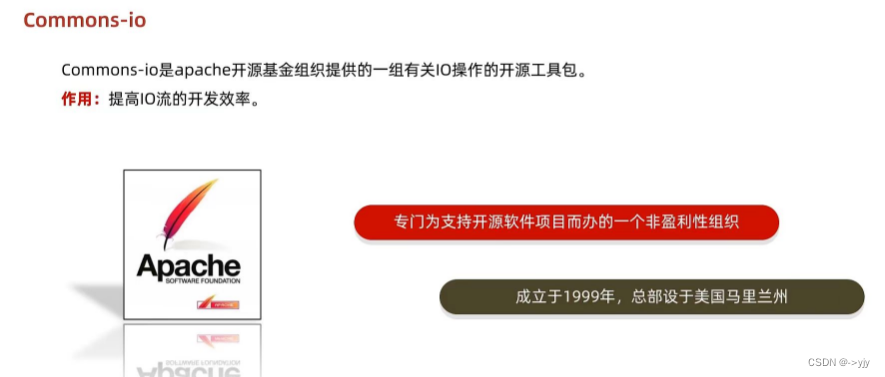

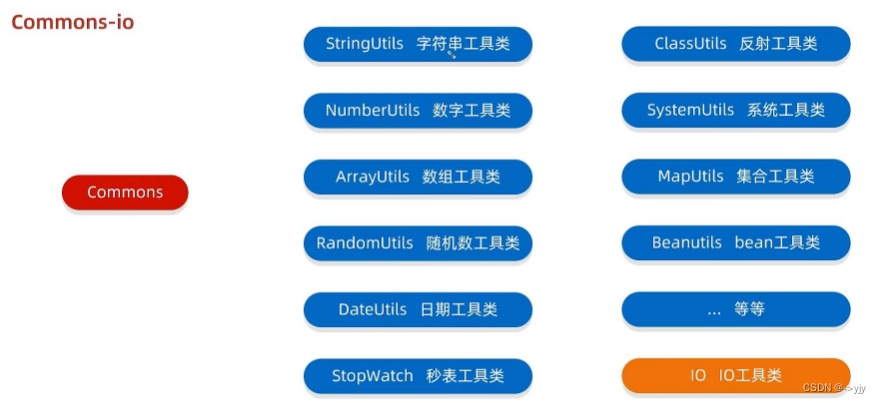

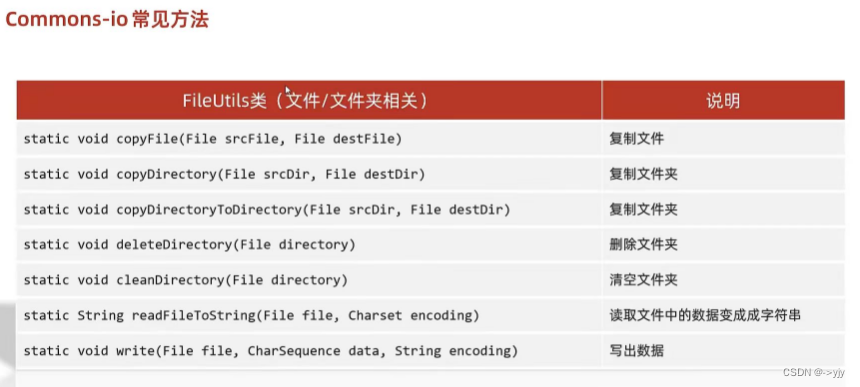
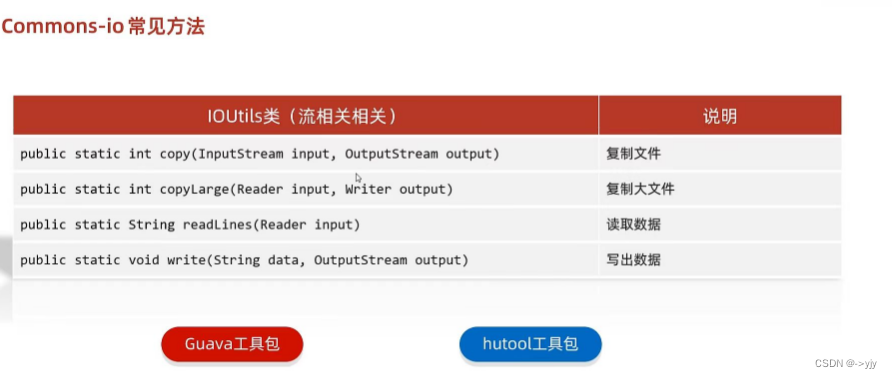
import java.io.File;
import java.io.IOException;
public class DEMO {
public static void main(String[] args) throws IOException {
// File src =new File("basic-code\\1.txt");
// File dest =new File("basic-code\\copy.txt");
//
// FileUtils.copyFile(src,dest);//用这个包直接拷贝了
// File src =new File("D:\\aaa");
// File dest =new File("D:\\bbb");
// FileUtils.copyDirectory(src,dest);
// File src =new File("D:\\aaa");
// File dest =new File("D:\\bbb");
// FileUtils.copyDirectoryToDirectory(src,dest);
//作用:bbb:里面有aaa然后有aaa里面的东西
File src =new File("D:\\aaa");
FileUtils.deleteDirectory(src);
File dest =new File("D:\\bbb");
FileUtils.cleanDirectory(dest);
}
}

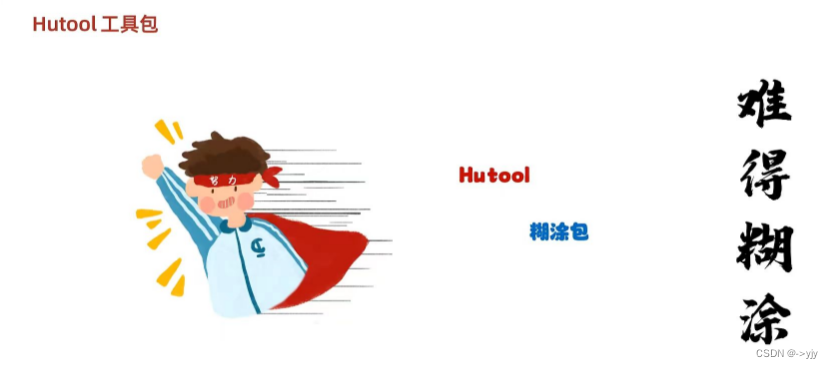


import java.io.File;
import java.io.IOException;
import java.util.ArrayList;
import java.util.List;
public class DEMO {
public static void main(String[] args) throws IOException {
//Hutool
//因为里面的方法都是静态的所以直接用类名就可以调用了
File file = FileUtil.file("D:\\aaa", "bbb", "a.txt");
System.out.println(file);//D:\aaa\bbb\a.txt
File f =new File("a.txt");
f.createNewFile();//如果父级路径不存在那么会报错
//Hutool 里面的touch方法如果找不到这个父级路径会帮我们创建
File touch = FileUtil.touch(file);
System.out.println(touch);
ArrayList<String>list =new ArrayList<>();
list.add("aaa");
list.add("aaa");
list.add("aaa");
File file1 = FileUtil.writeLines(list, "D:\\a.txt", "UTF-8", false);
System.out.println(file1);
File file2 = FileUtil.appendLines(list, "D:\\a.txt", "UTF-8");
System.out.println(file2);
List<String> strings = FileUtil.readLines("D:\\a.txt", "UTF-8");
System.out.println(list);
}
}官网:
https://hutool.cn/
API文档:
https://apidoc.gitee.com/dromara/hutool/
中文使用文档:
https://hutool.cn/docs/#/
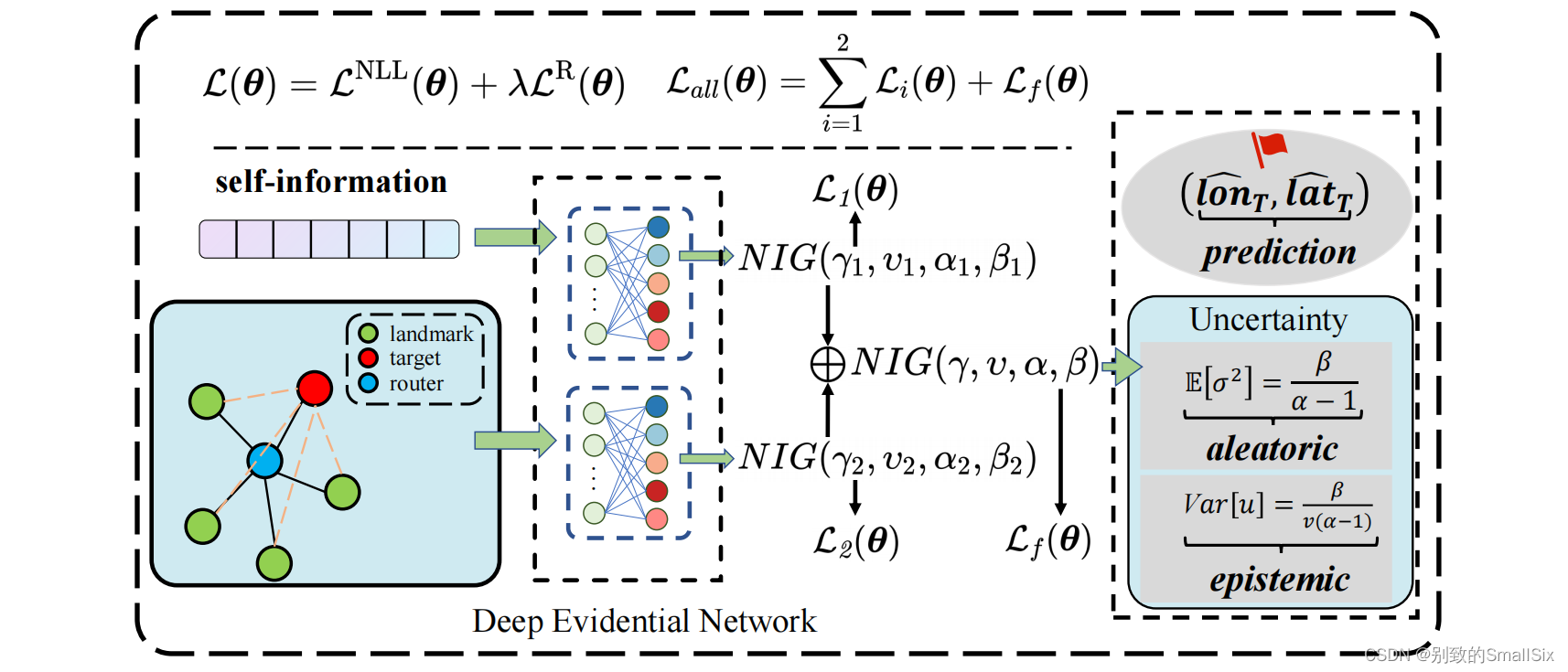



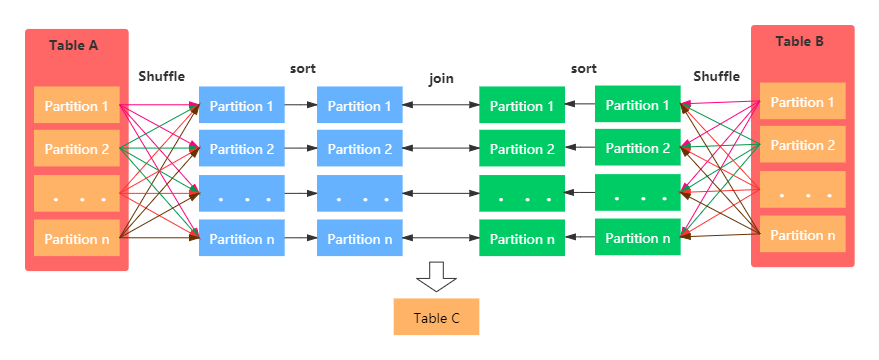
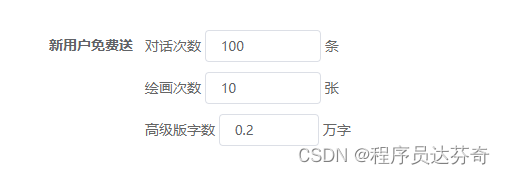

![[NAND Flash 4.1] Flash(闪存)存储器底层原理 | 闪存存储器重要参数](https://img-blog.csdnimg.cn/direct/a85eca0f4e874071b5cebc43aa8a2049.png#pic_center)


